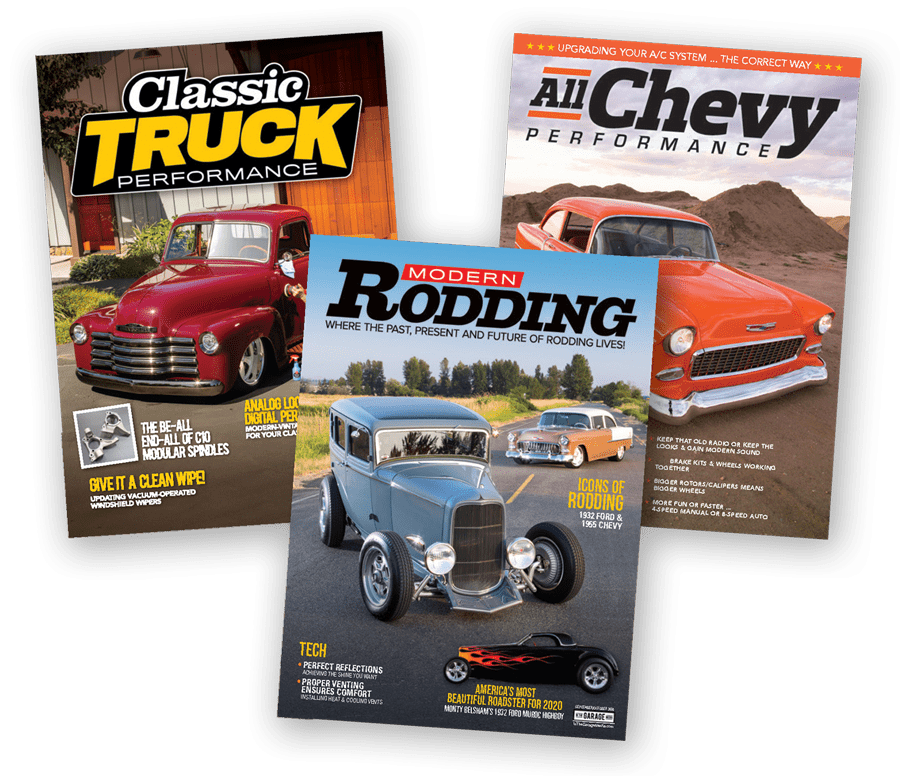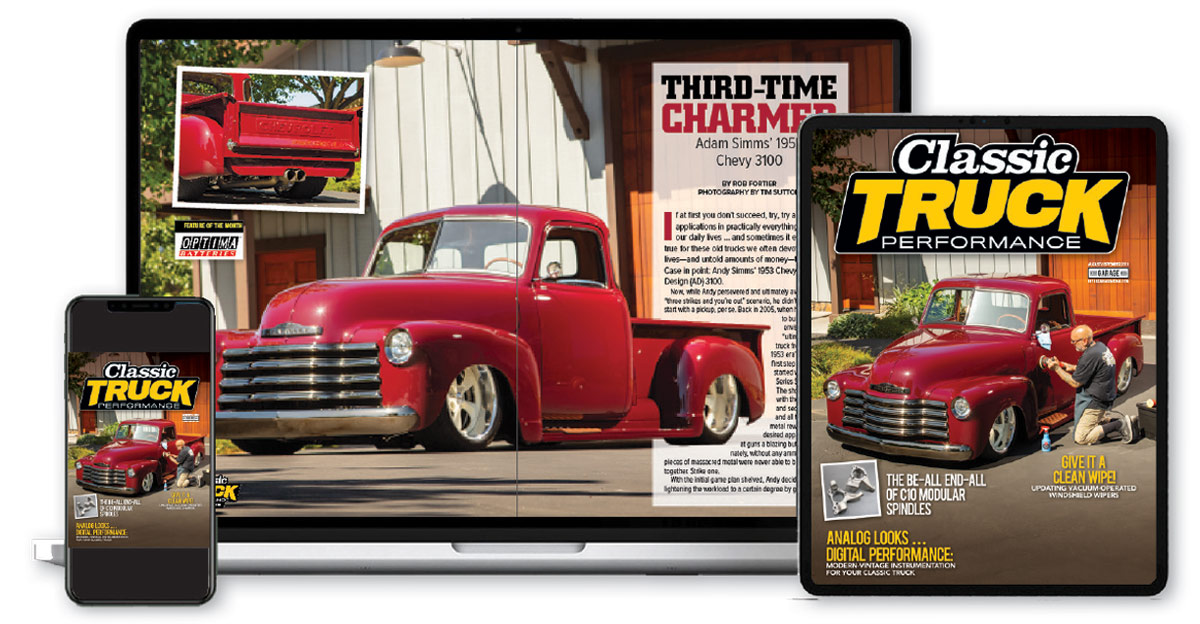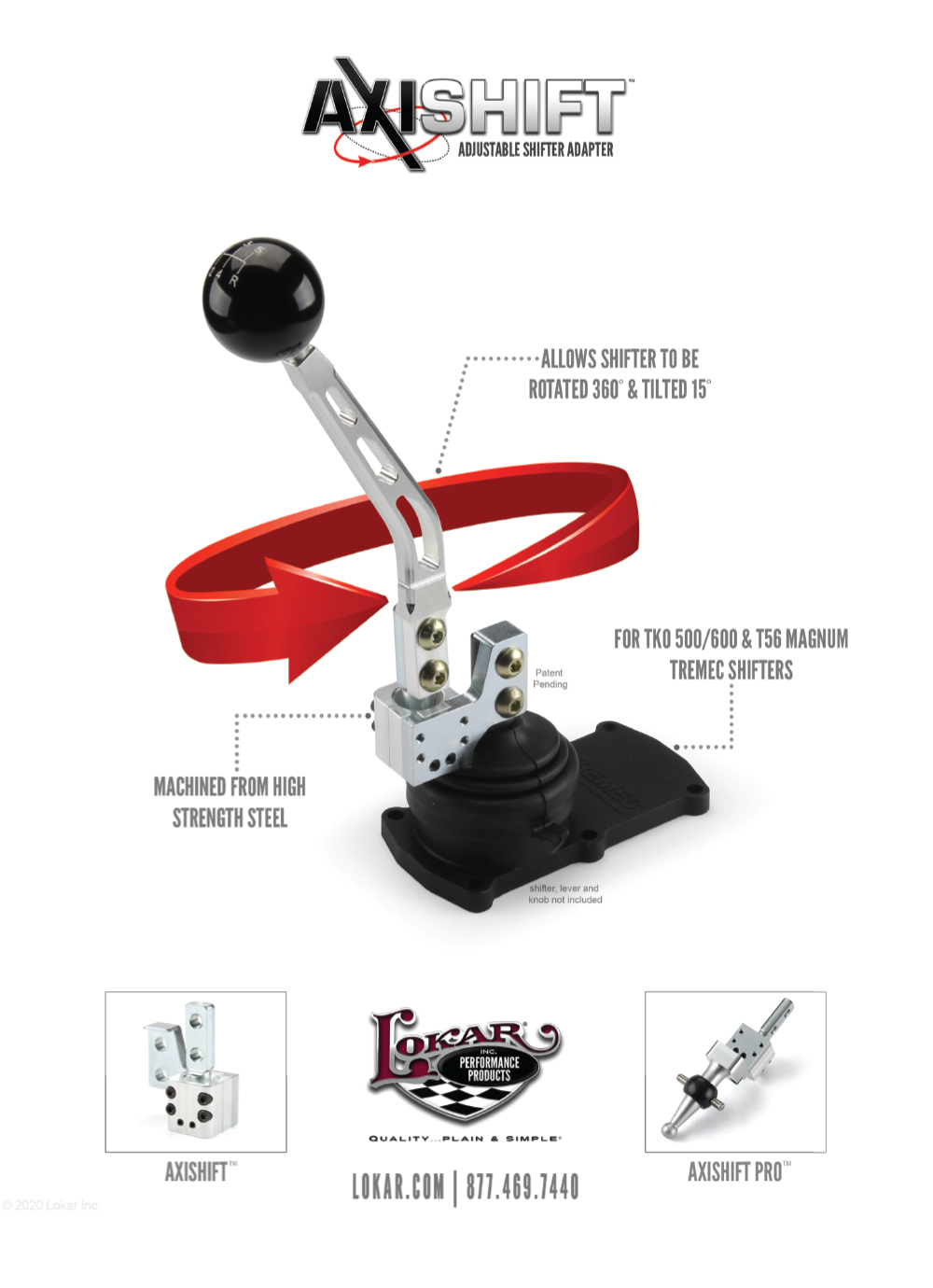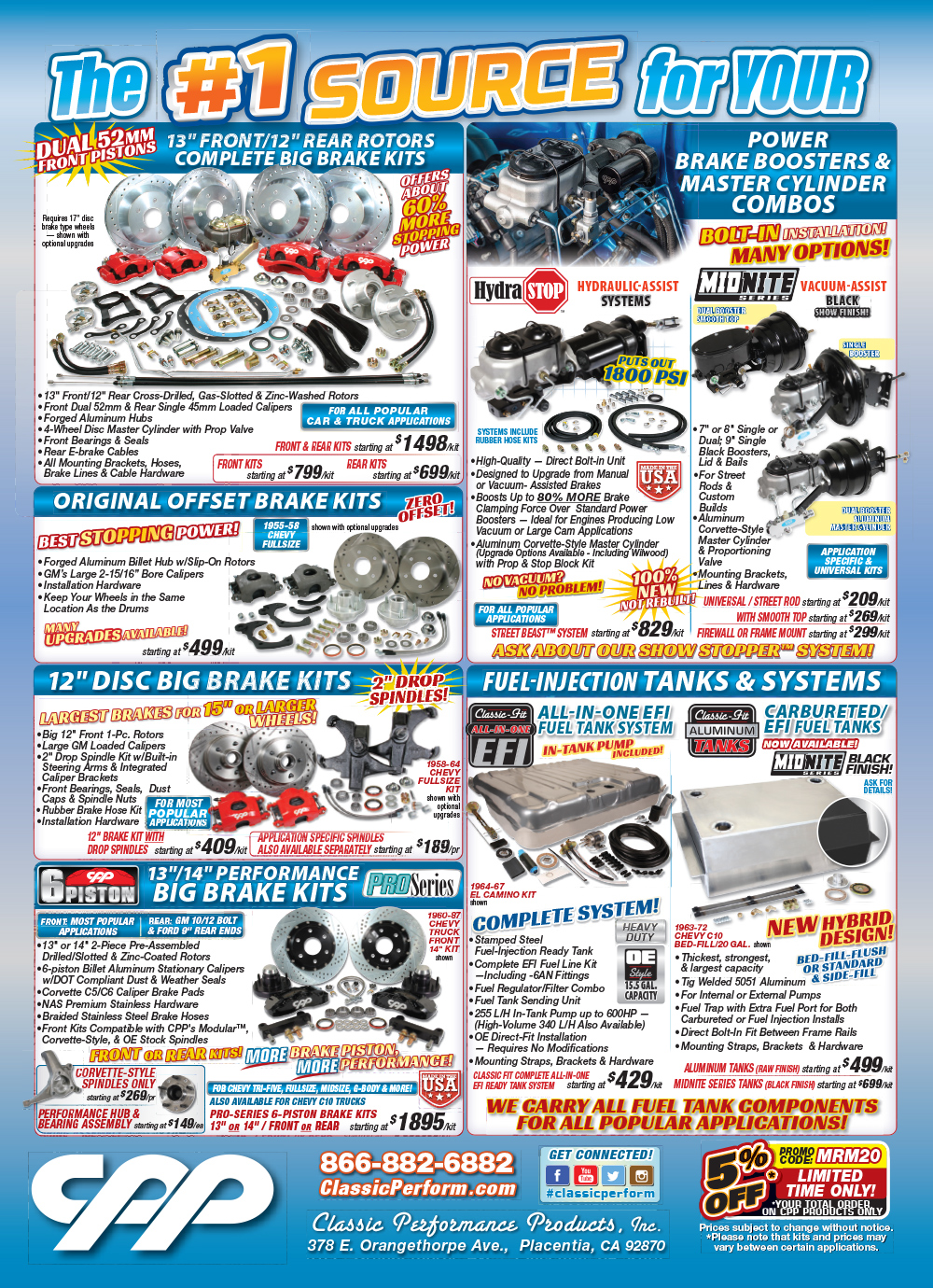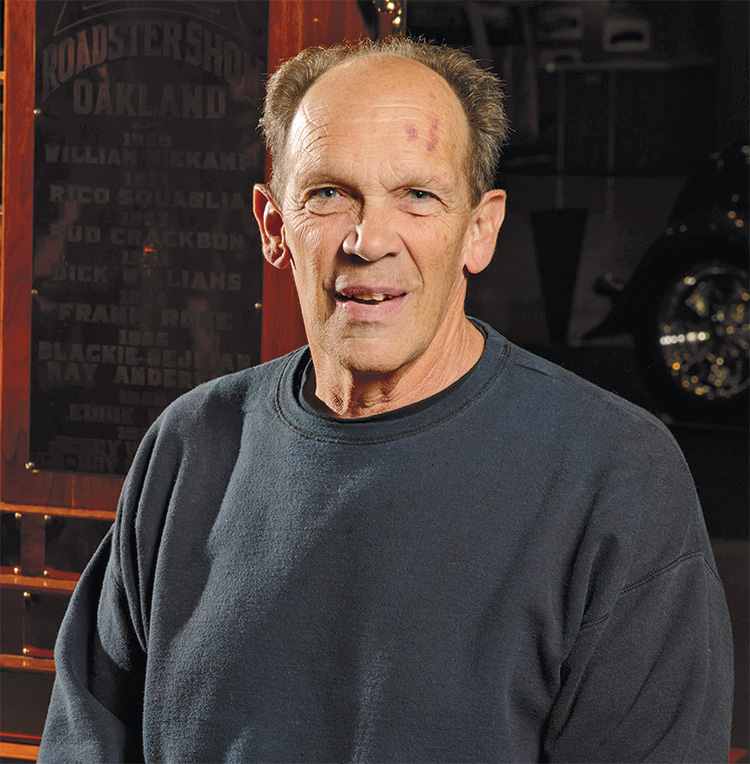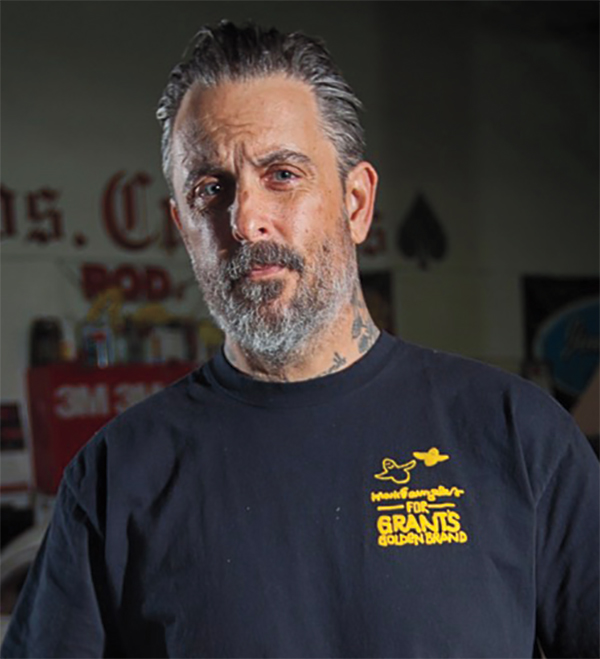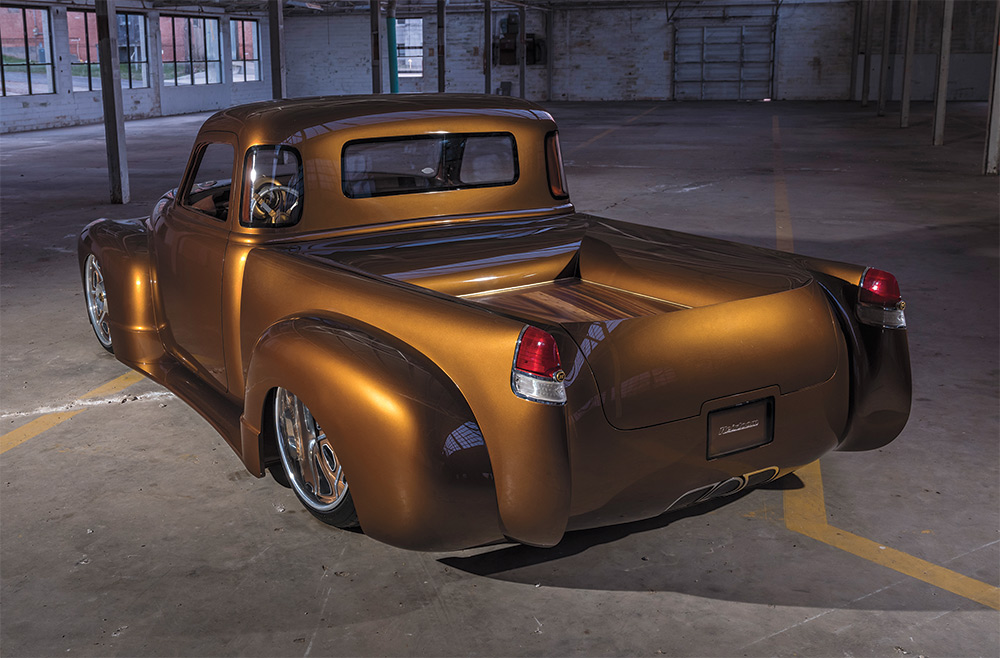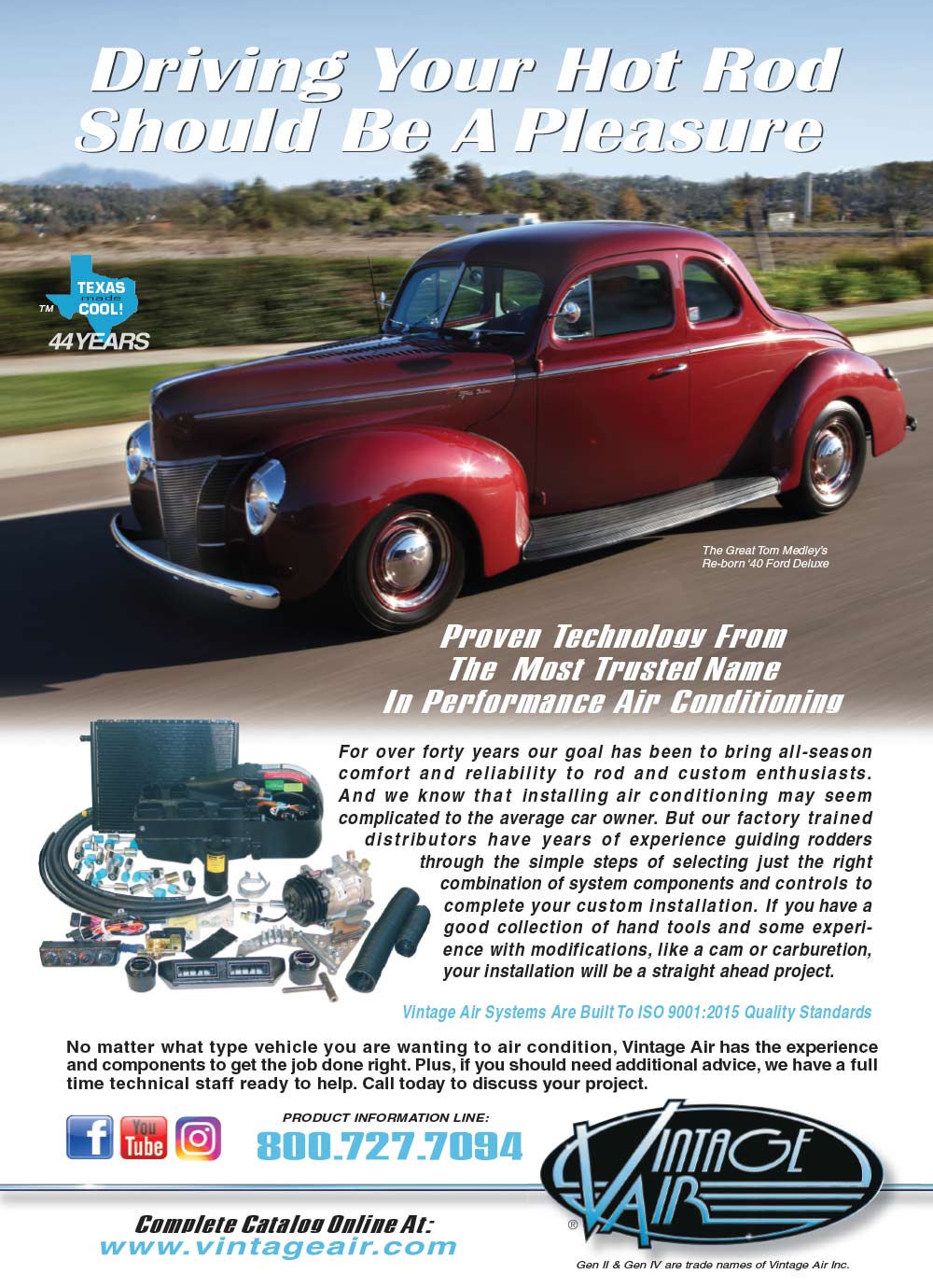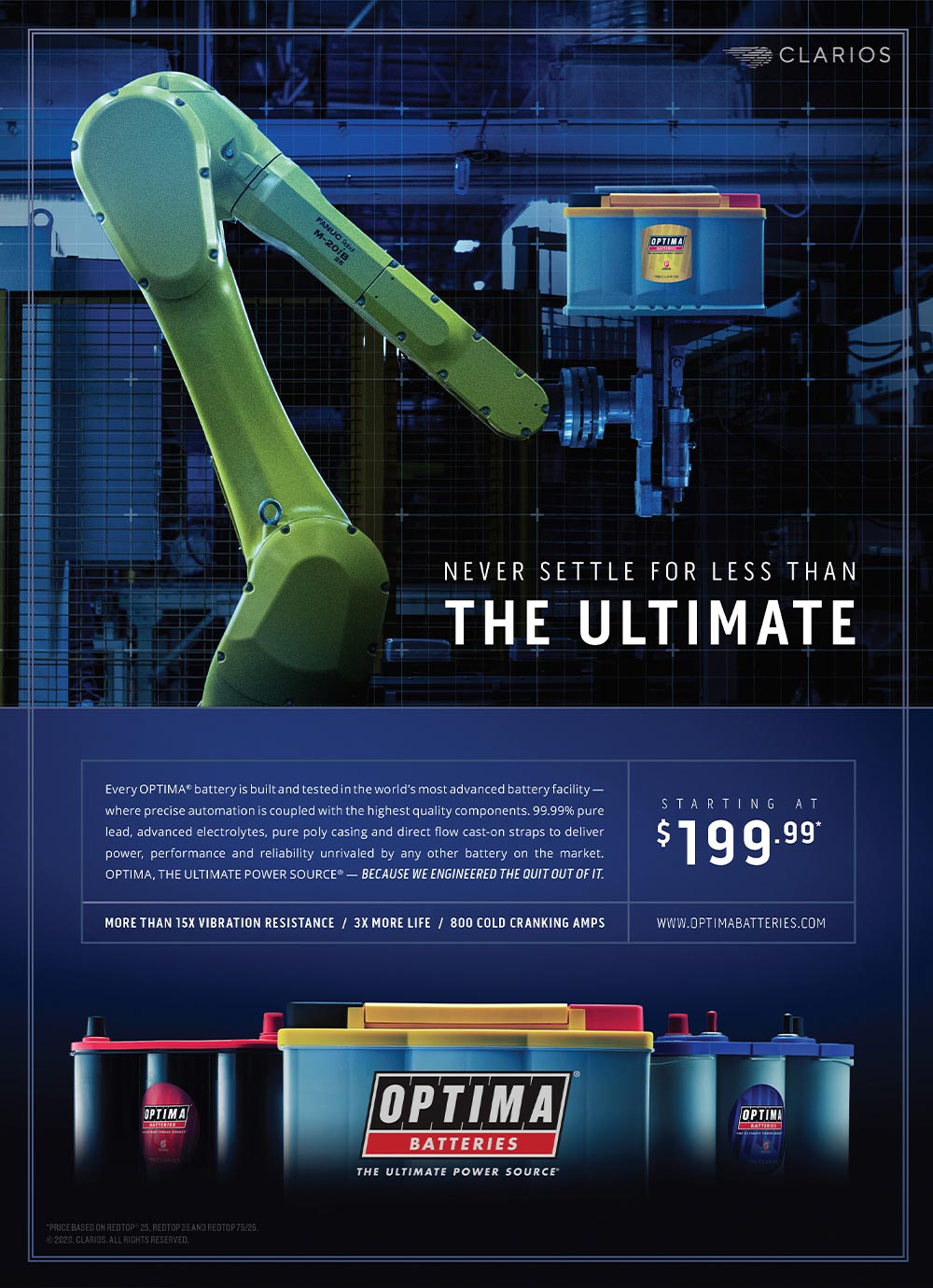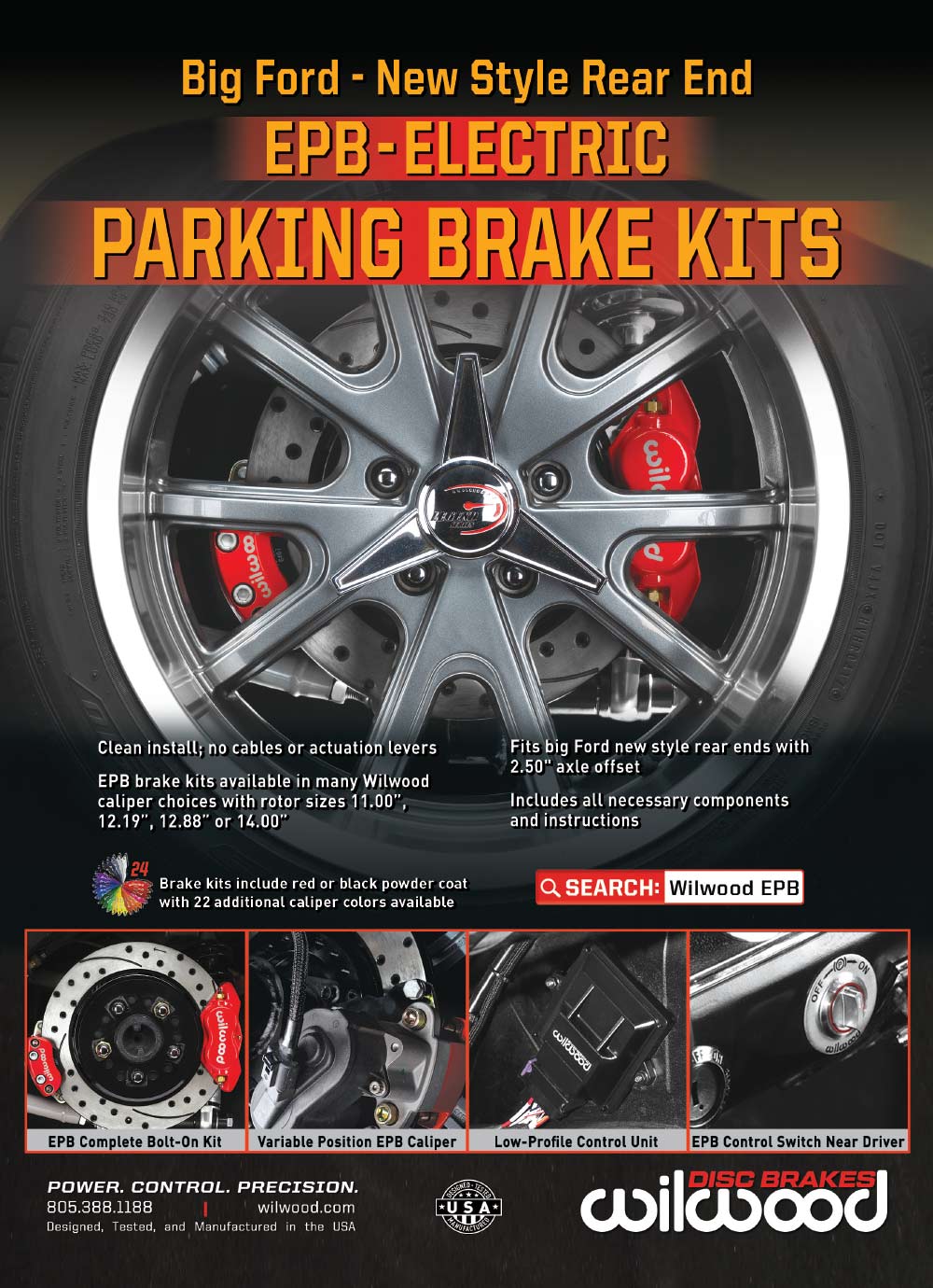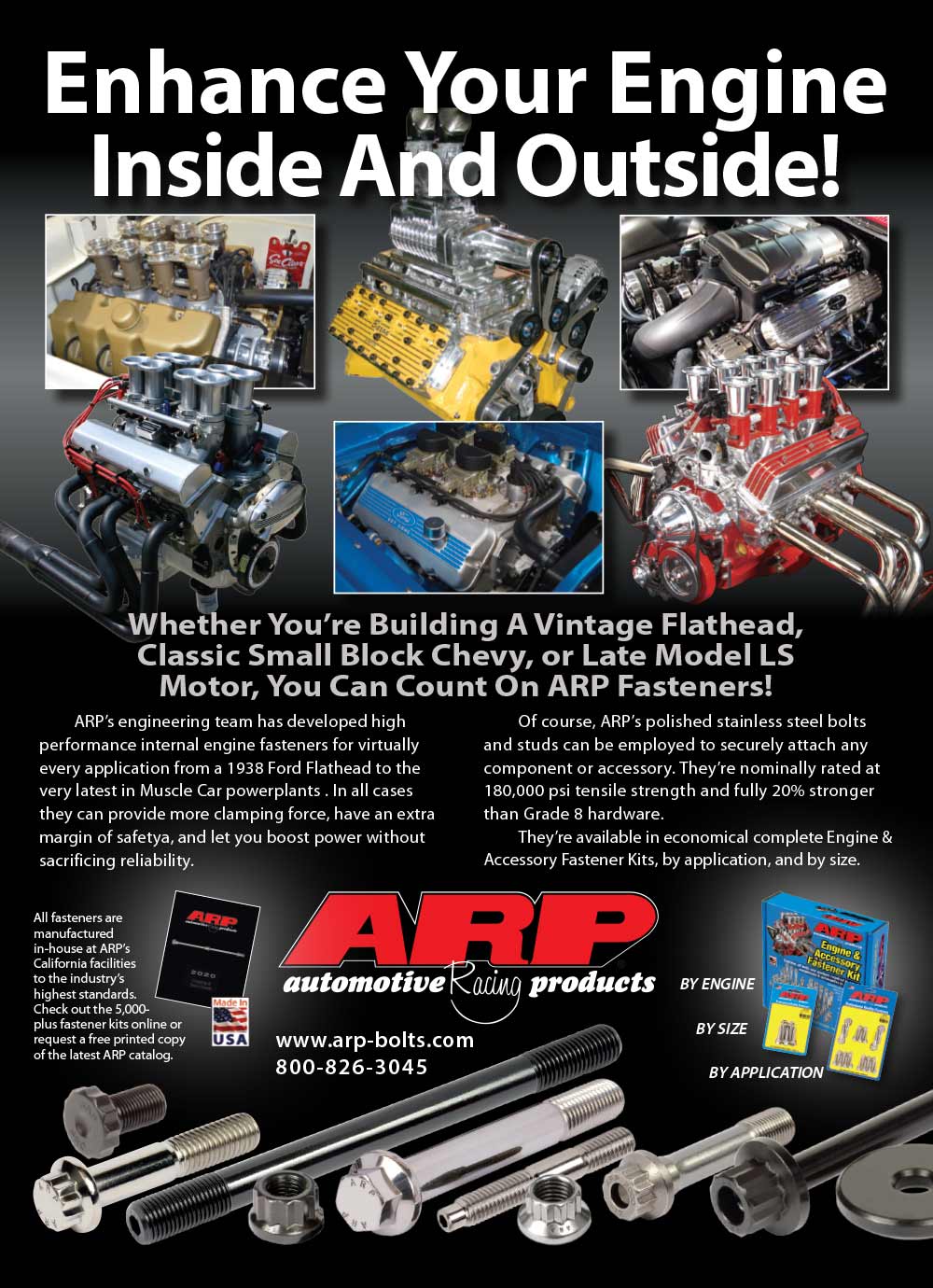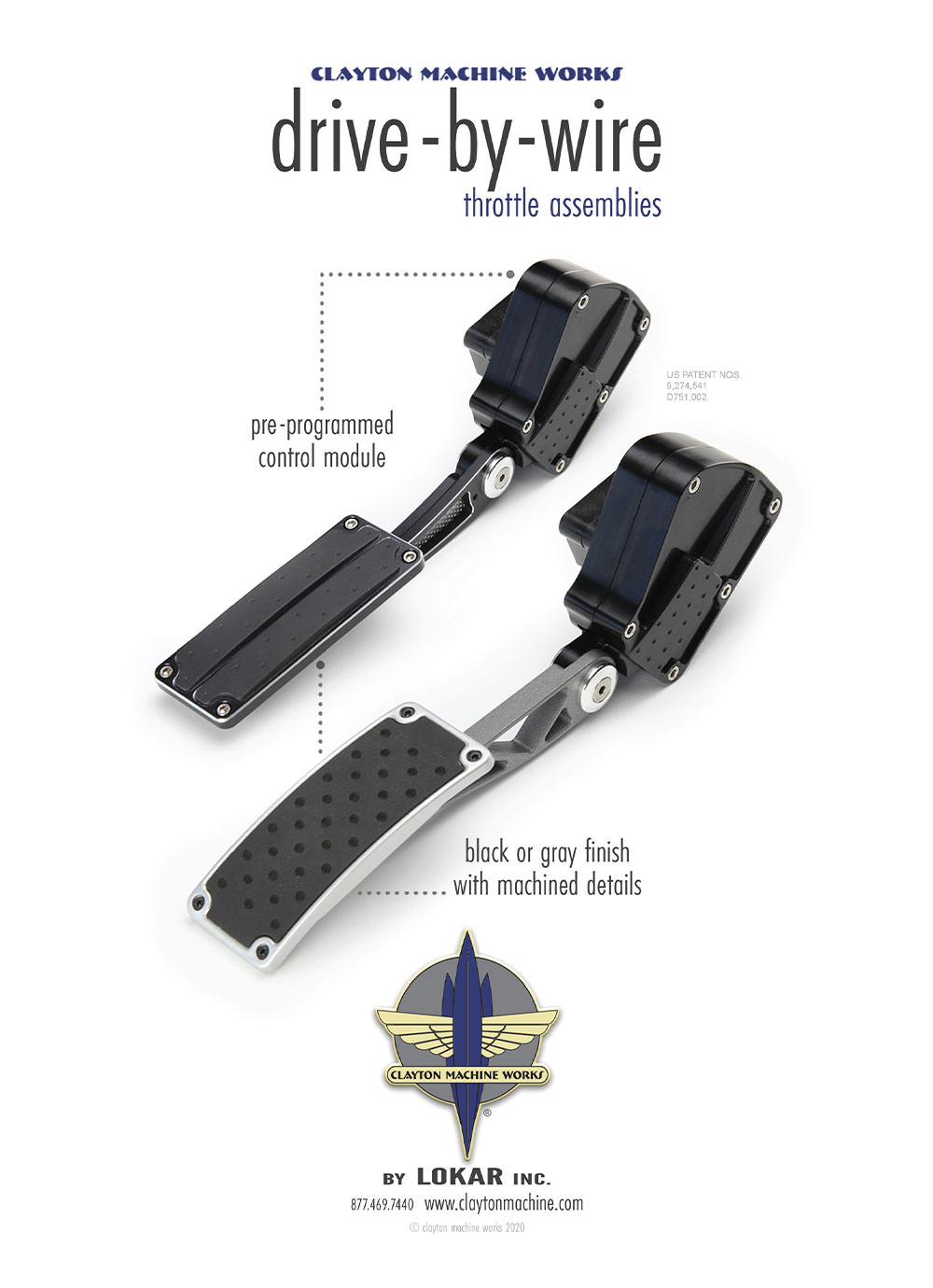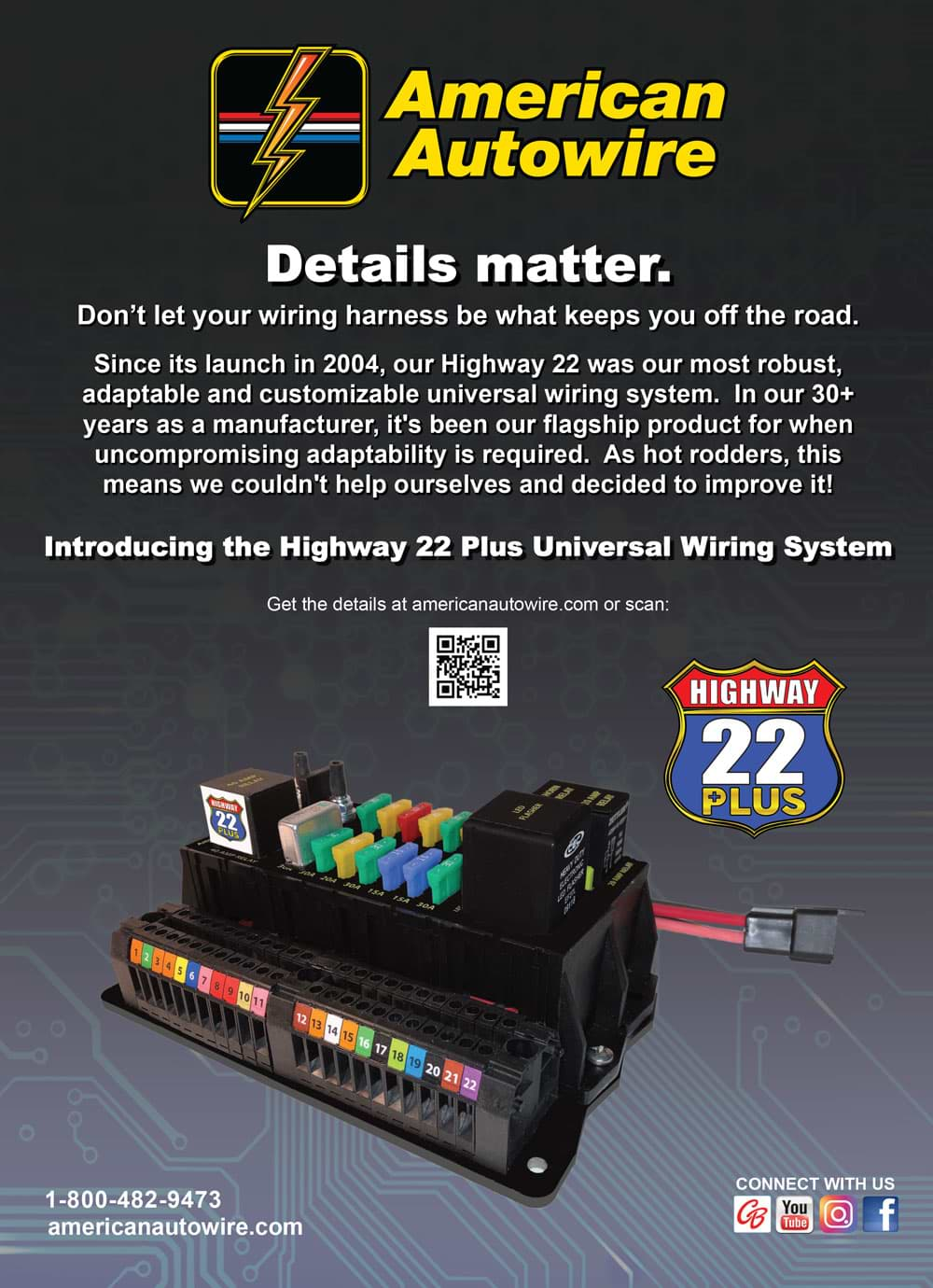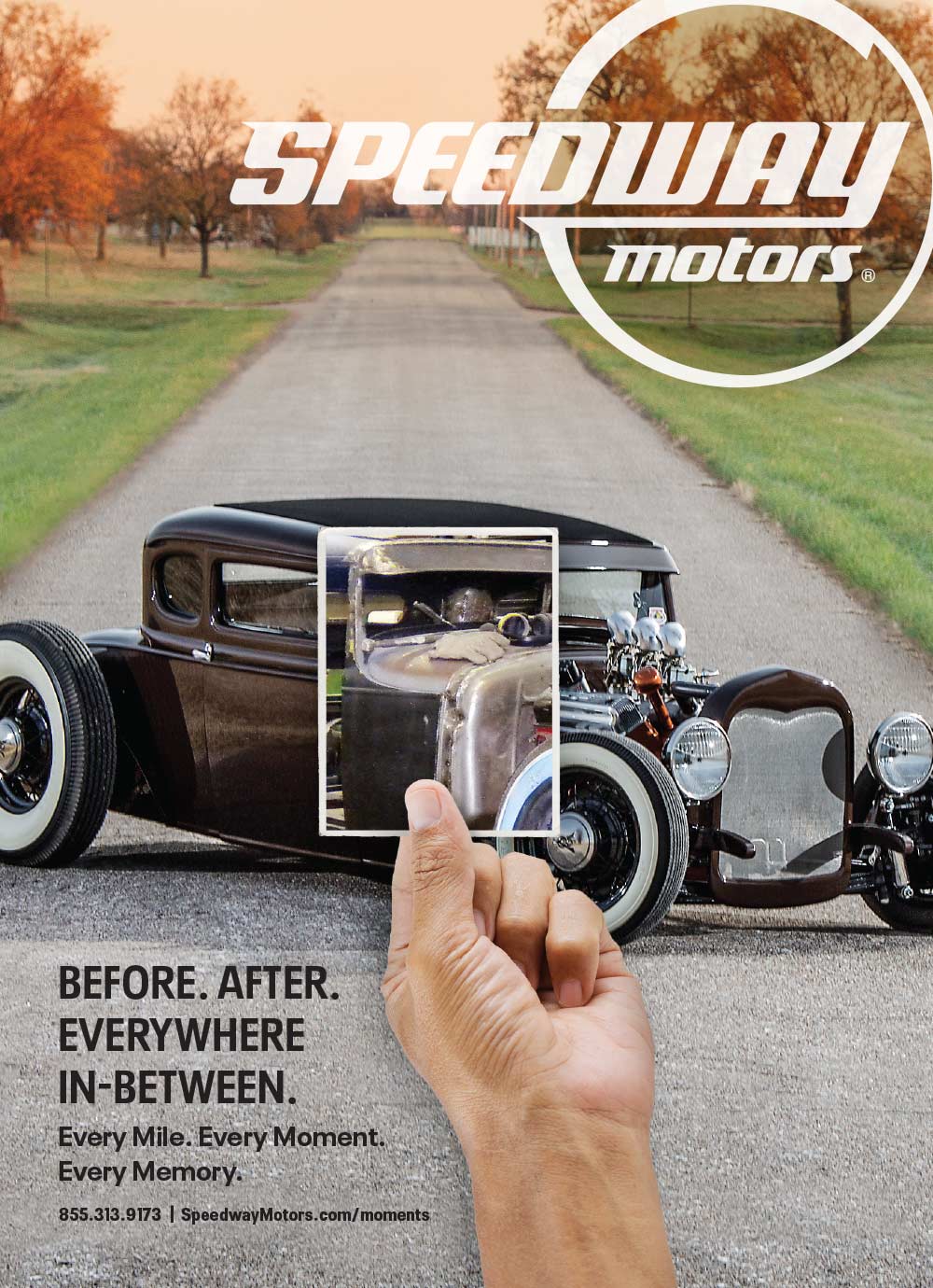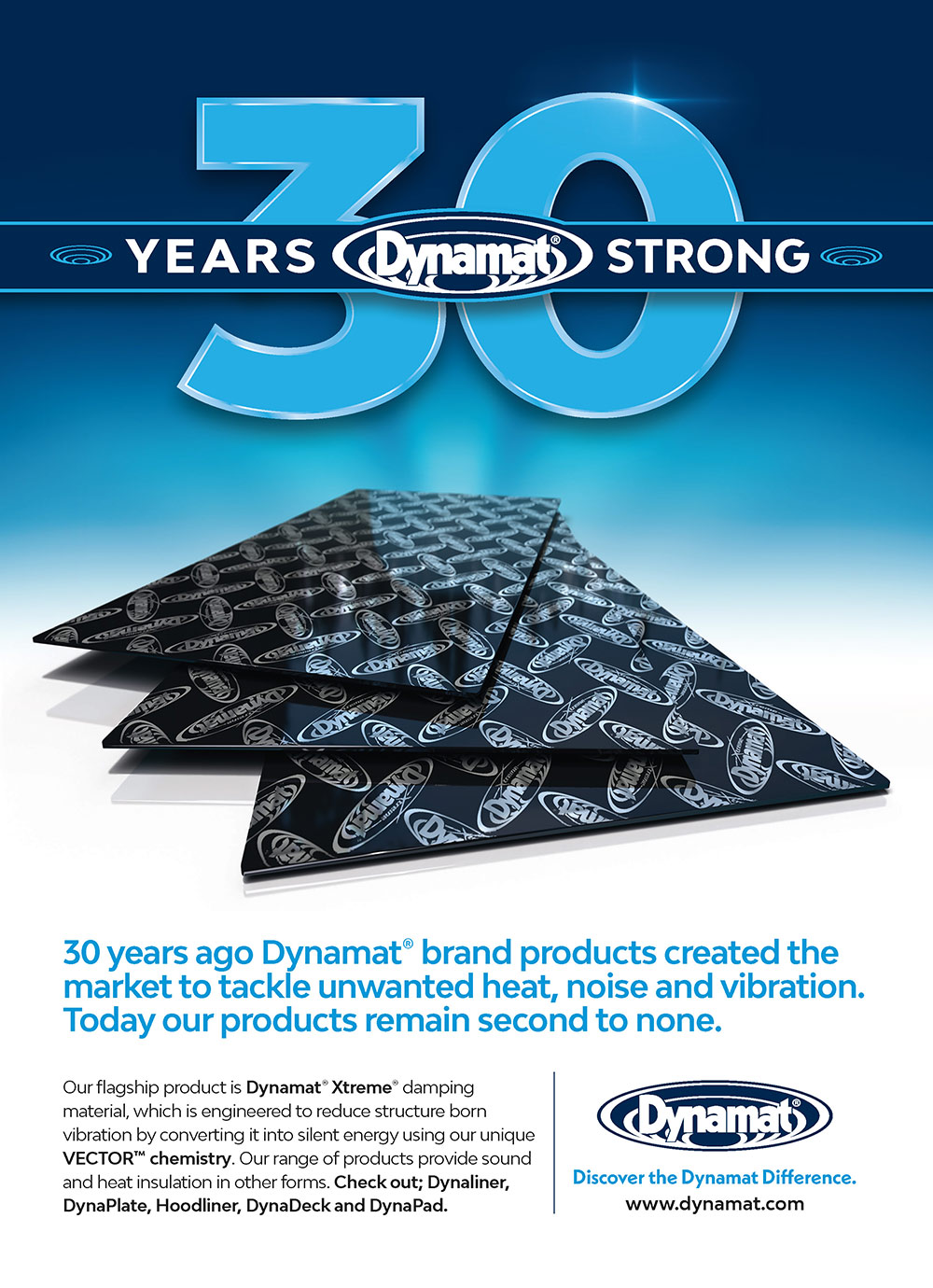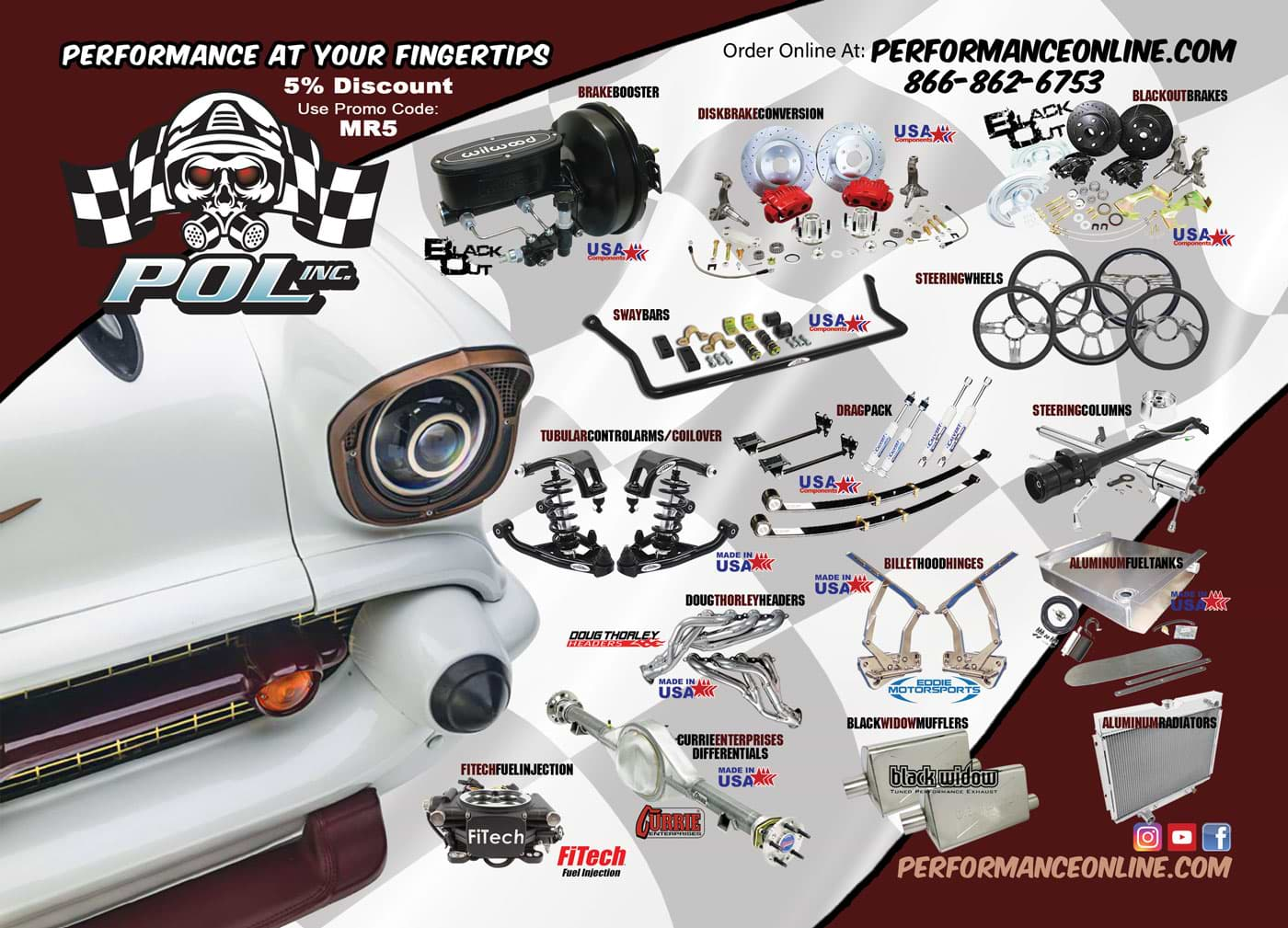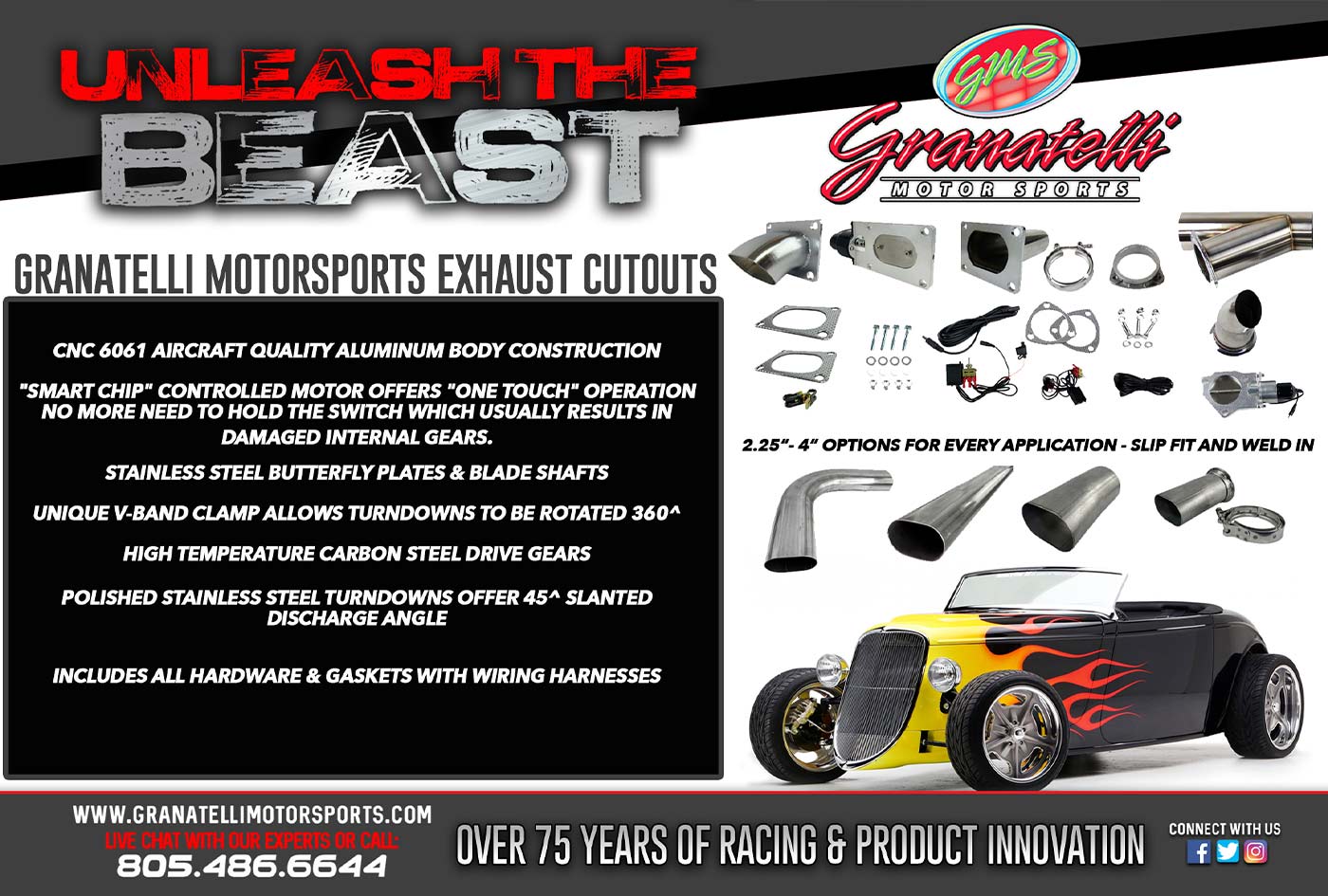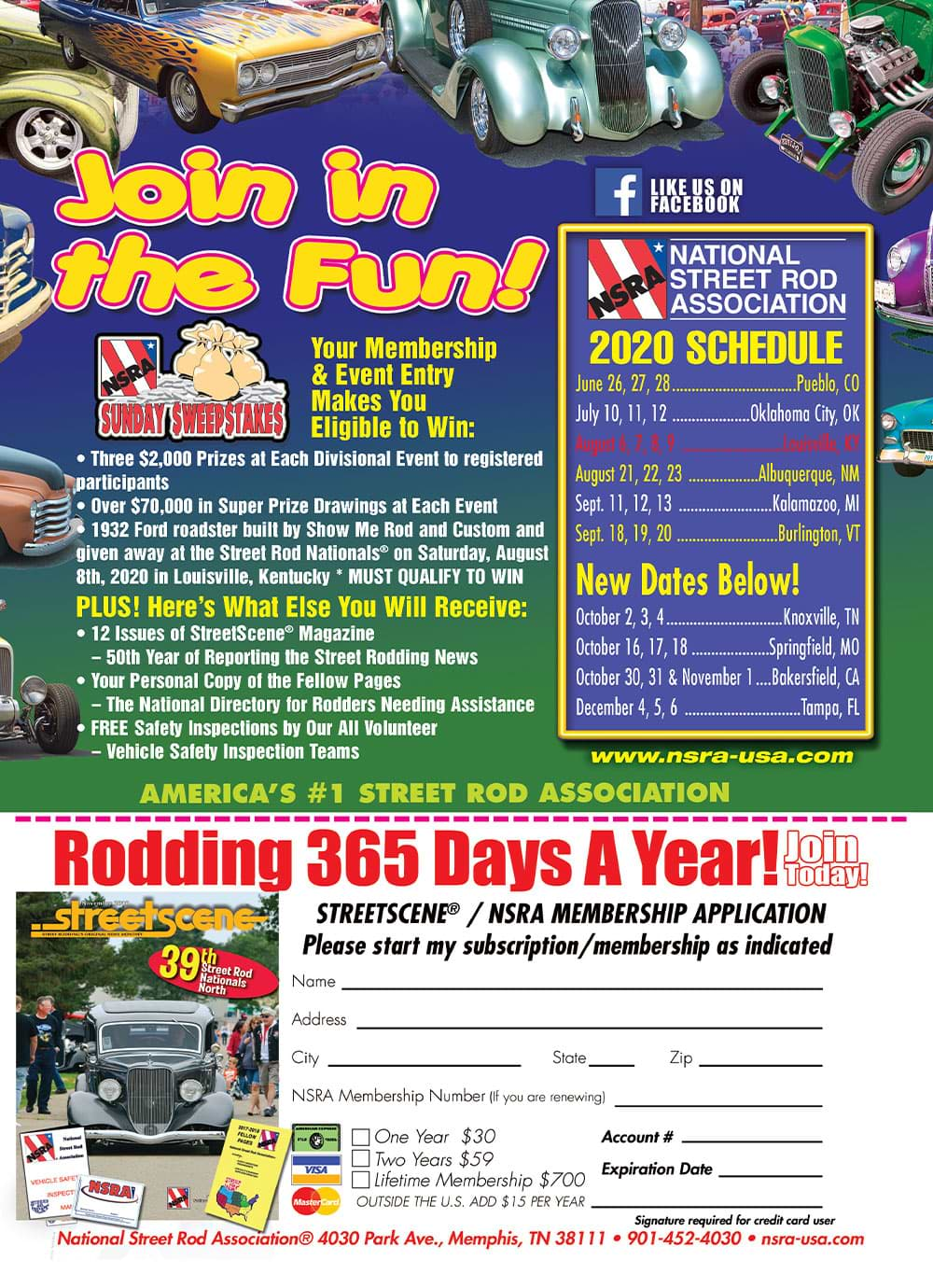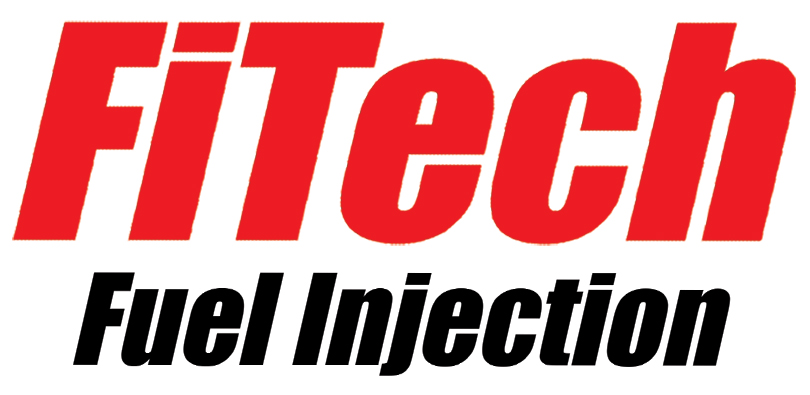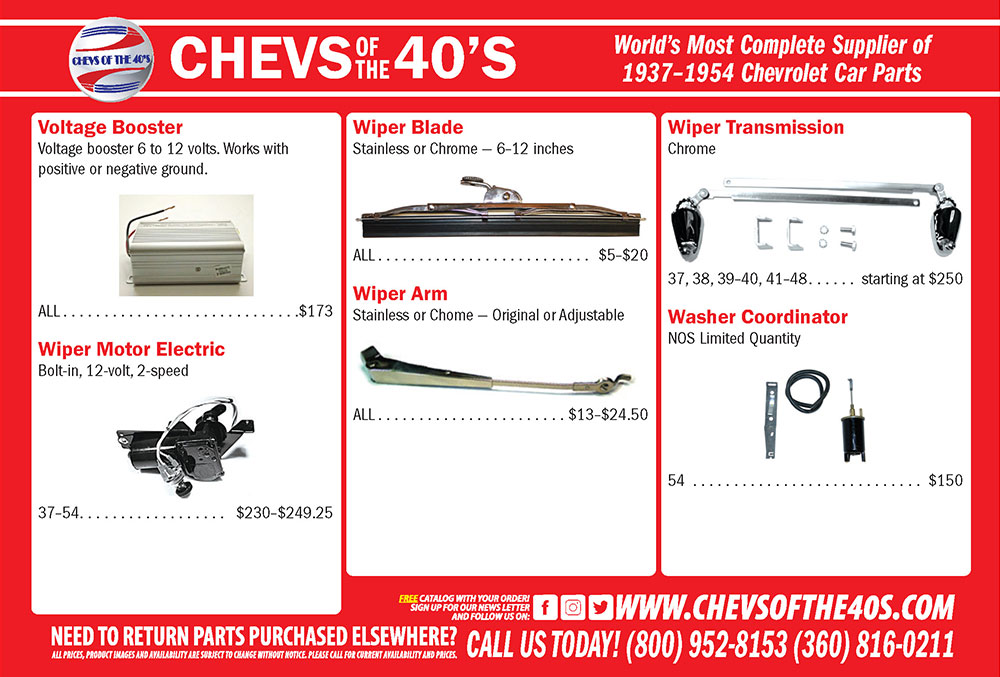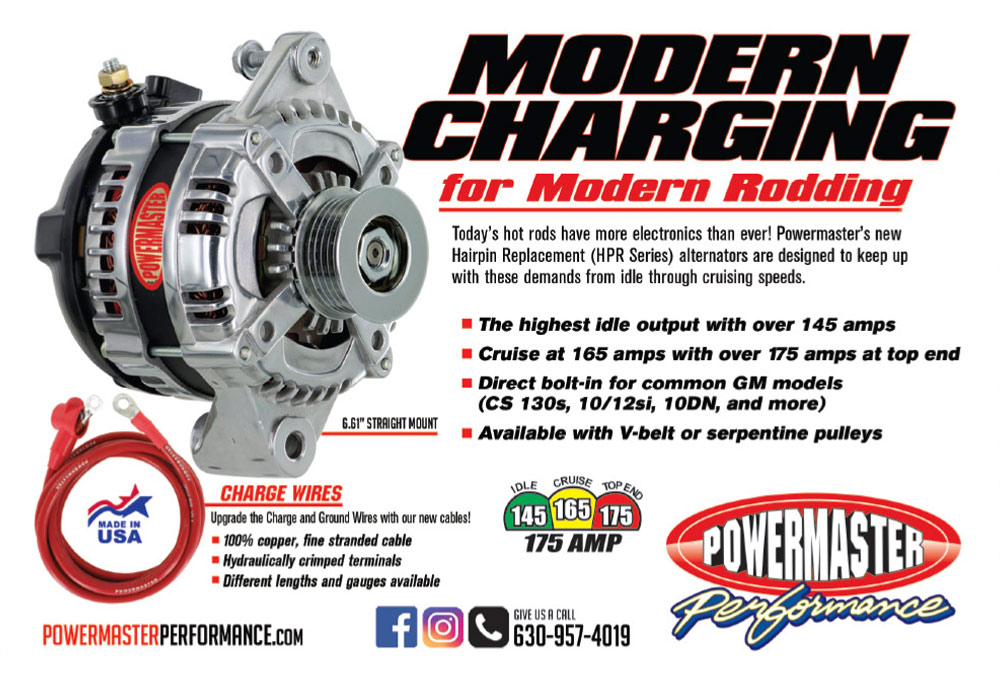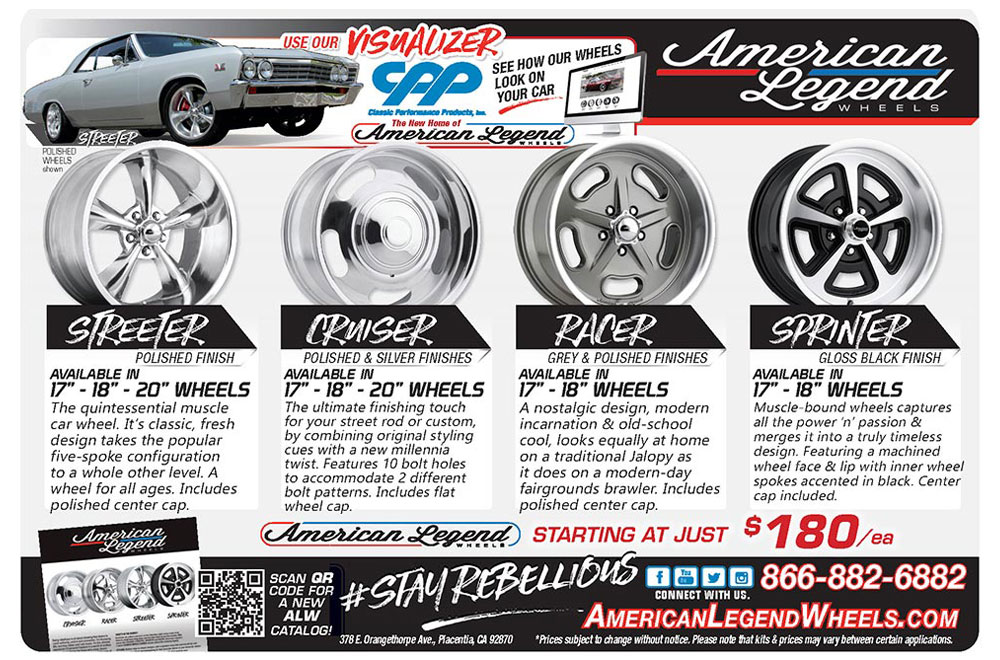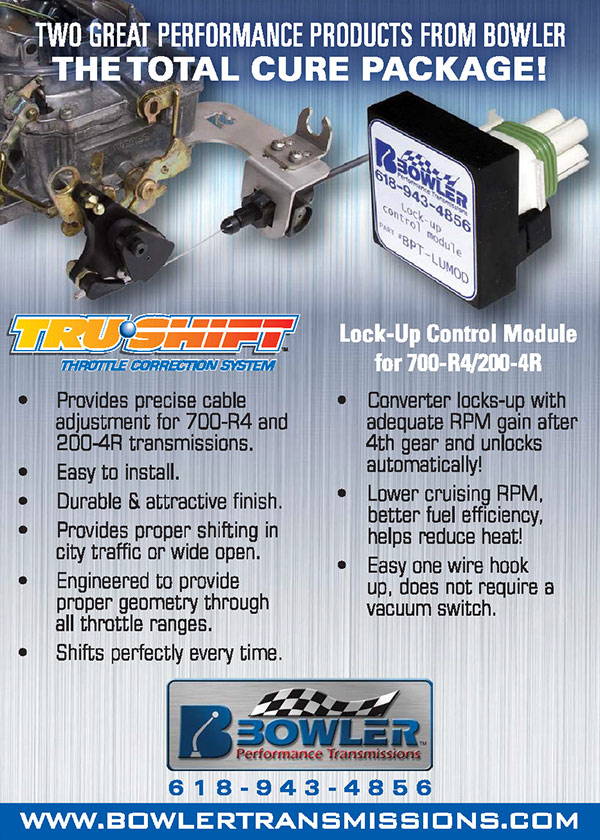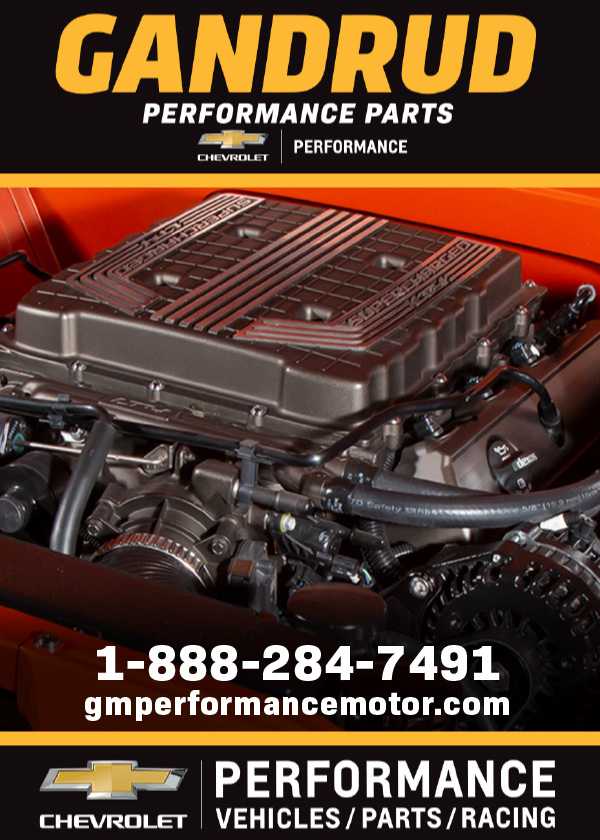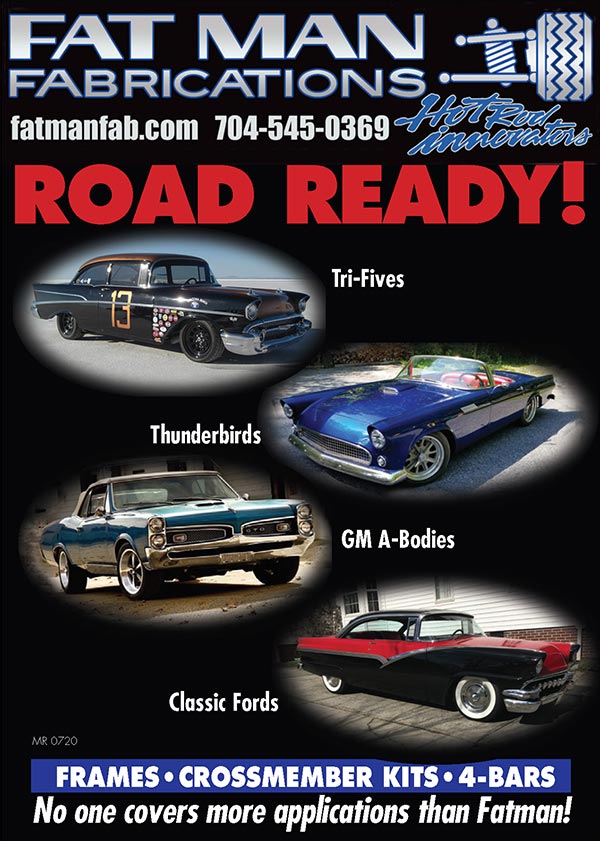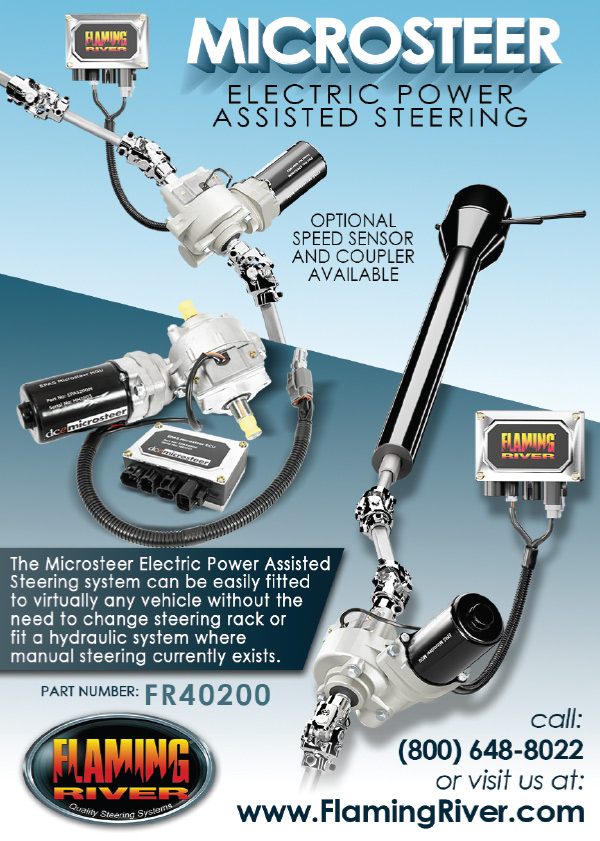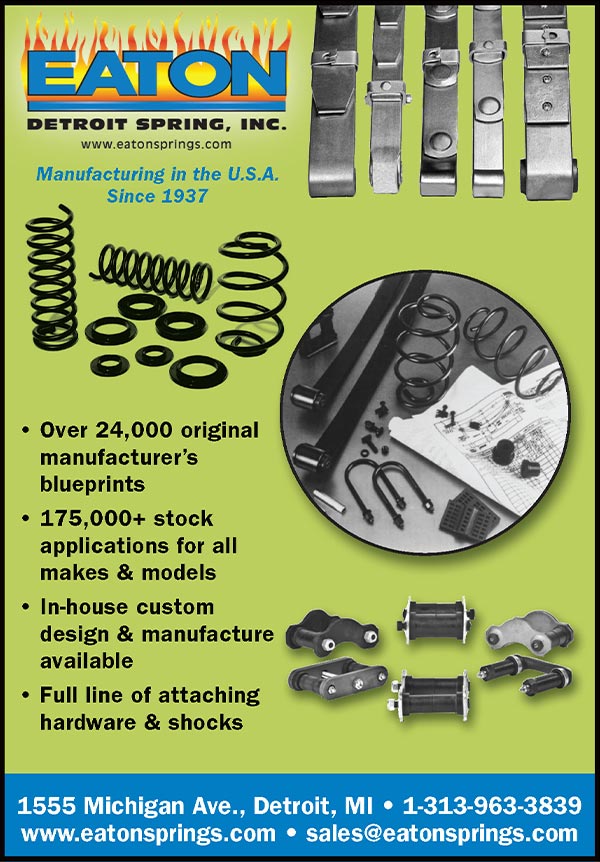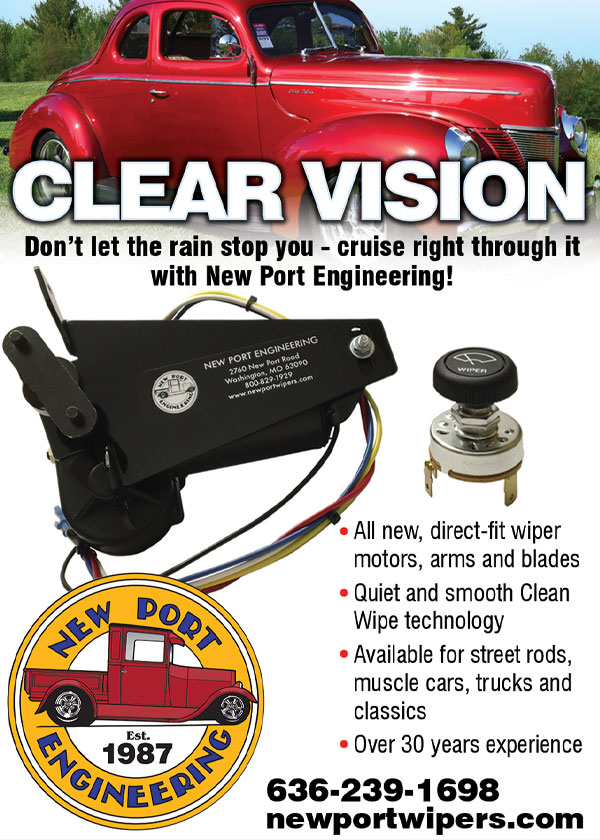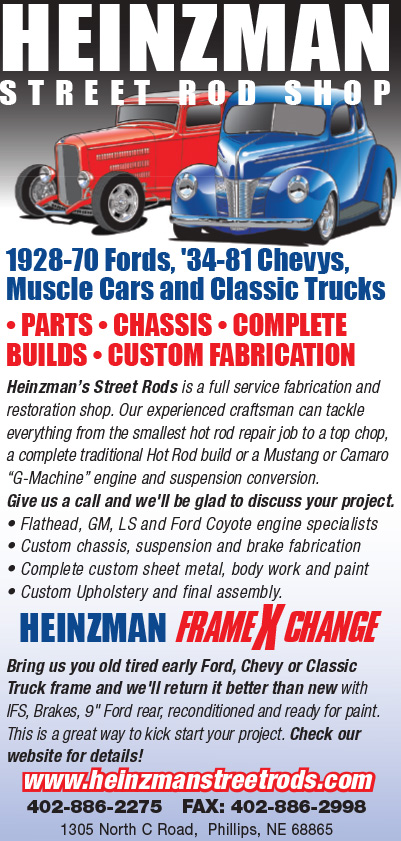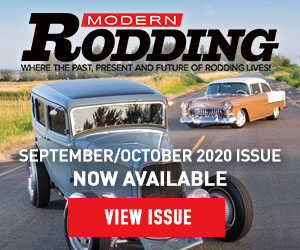of the Movie
Vanishing Point
Installing
Windshield Wipers
Understanding
Battery Storage

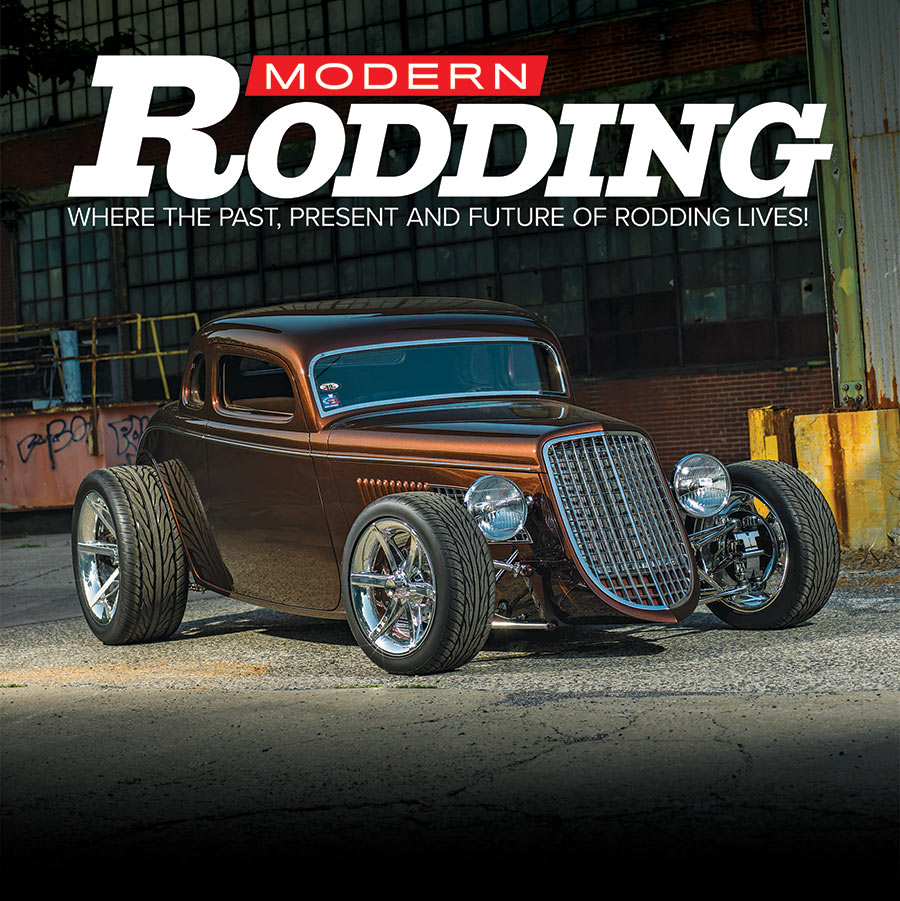
of the Movie
Vanishing Point
Installing
Windshield Wipers
Understanding
Battery Storage


The Ultimate Car Chase Movie … or at Least One of Them

The 1933 Ford Coupe has the Look That, When Done Right, is Unmistakable
Hell(Cat) … On Wheels
This 1971 ’Cuda is Both Aesthetically Pleasing and Thunderously Powerful
The Pierson Brothers 1936 Ford Coupe Did it All
Maverick
By Definition a Loner, but This 1972 Ford is at Home in any Crowd
Transforming Modern into Classic
Wiped Clean
New Port Engineering’s 1935-1936 Ford Clean Wipe Wiper System
Part 1: The Art Morrison Enterprises GT Sport Chassis for Your 1959-1964 Chevy
Keep a Light On
Good Idea for Your Front Porch but not Such a Good Idea for Your Battery
Rise to the Occasion
Taking Your New Air Breathers to New Heights and Dimensions
This 1933 Ford chopped-and-channeled coupe is owned by Rocky Boler and represents a number of ideas he wanted in a hot rod. It was built under the watchful eye and craftsmanship of Creative Rod & Kustom. Photography by John Jackson
It’s the rage to take something old and make it look like something new but now turnabout is fair play. Let’s take something new like a Chevy LS3 and turn it into a vintage small-block or big-block Chevy V-8 using one of the LS Classic Series by Lokar systems.
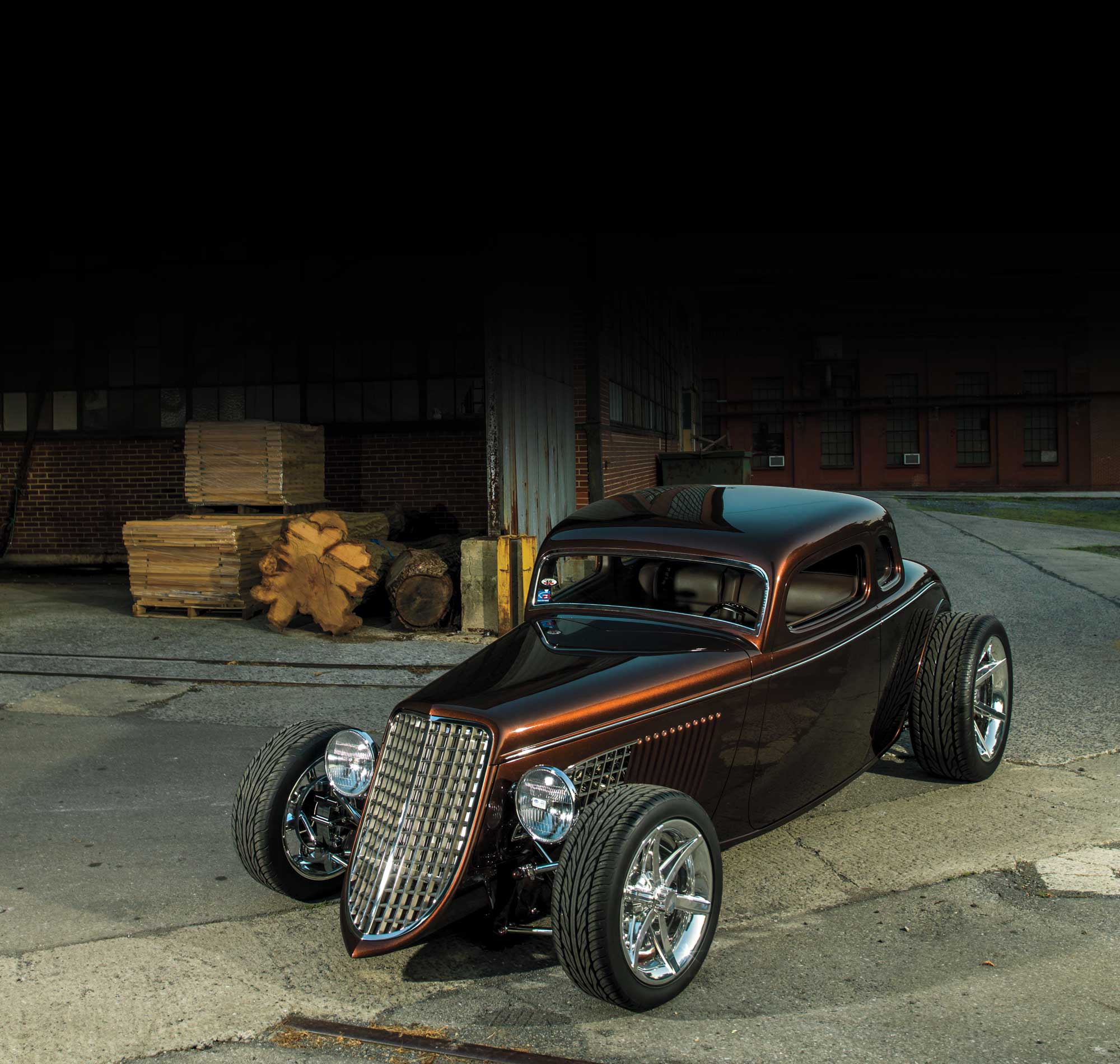

Sarah Gonzales – Copy Editor
Rodney Bauman, Gerry Burger, Tommy Lee Byrd, Ron Ceridono, Michael Christensen, Ron Covell, Grant Cox, John Drummond, Eric Geisert, Joe Greeves, John Jackson, Barry Kluczyk, Scotty Lachenauer, Ryan Manson, Josh Mishler, Gary Rosier, Chris Shelton, Mike Slade, Jeff Smith, Tim Sutton, Chuck Vranas – Writers and Photographers
Mark Dewey – National Sales Manager
Janeen Kirby – Sales Representative
Patrick Walsh – Sales Representative
ClassicTruckPerformance.com
ModernRodding.com
AllChevyPerformance.com
InTheGarageMedia.com

All rights reserved. Printed in the USA.
Copyright (c) 2020 IN THE GARAGE MEDIA
The Modern Rodding trademark is a registered trademark of In The Garage Media. Modern Rodding. November/December 2020, Vol. 1, No. 3 is published bi-monthly by In The Garage Media. 1350 E. Chapman Ave. #6650, Fullerton, CA 92834-6550
ISSN 2692-2371
PRINTED IN U.S.A.


or those of us living on the West Coast we are now aware the governor of California has determined by 2035 there will be no more freshly minted internal combustion engine gas-powered cars or trucks sold within the state. Experience has taught us as California goes, with regard to clean air emissions, other states aren’t too far behind. How does that impact our hot rods? We will still have them but the very nature of our hobby dictates that we be ready to change and adapt in order to move forward.
That got me thinking about a patina-covered 1949 Mercury that was on display in the Optima Batteries booth at the 2018 SEMA Show. I should have realized something was up by the name attributed to it, “1949 Mercury EV Derelict.” My first gaze went to the interior. I see what appears to be an iPad mounted to the dash where the factory gauges once resided. An immediate look under the hood yielded the “ah ha” moment. Before my baby blues I see the word “ICON” boldly cut into the “valve covers” of the electric motor (or is it engine?) powered 1949 Merc resting there in full patina.
The company ICON, known for building recreations of yesteryear nameplates with uncompromising attention to detail and the use of technology, is currently at the top of its game. You may have seen one of their designs, such as the ICON FJ (vintage Toyota), ICON BR (vintage Bronco), ICON TR (vintage Advance Design, 1948-1952, Chevrolet/GMC pickup). In this case, it’s the ICON Derelict series where our 1949 Merc came from. To ICON, the smallest details are never forgotten. The 1949 Mercury EV Derelict was commissioned by a longtime ICON client with the express purpose to push both the boundaries of design and engineering.

What’s going on – in Classic Truck Performance…
an you believe it—we’re already onto our third issue of Modern Rodding … which means the fourth issue of Classic Truck Performance is nearing completion as you read this! I wouldn’t say times flies in crazy times as such, but the last eight months have sure come and gone rather quickly—and we’re still here making magazines!
As I mentioned last month, my editorial in MR moving forward will be devoted to spreading the word regarding what’s on the horizon in sistering CTP—in the magazine, on the site, and out and about in general. As mentioned, we’re already in production on our fourth issue, which in and of itself is somewhat of a miracle in lieu of the current social climate and whatnot.

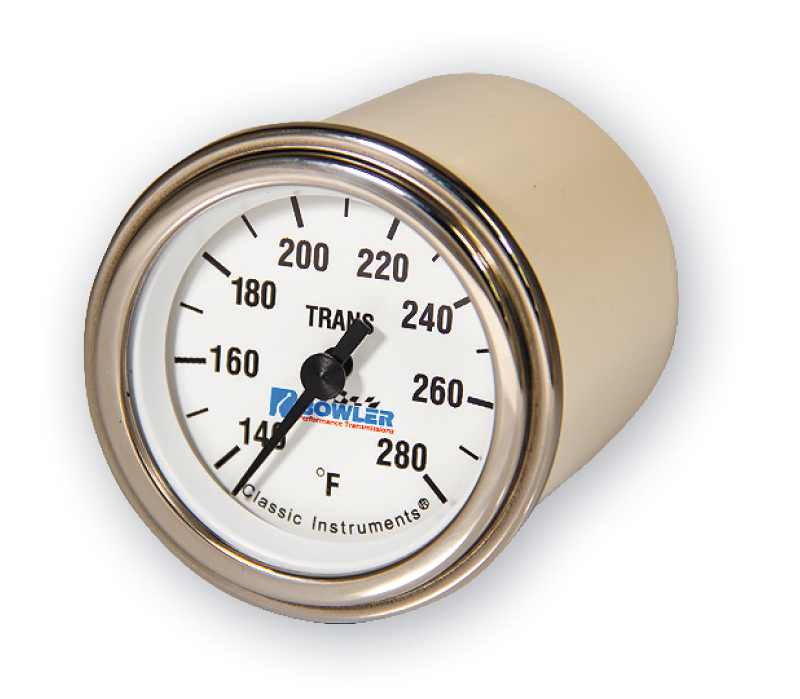
Bowler Performance Transmissions has partnered with Classic Instruments to bring you a classic-styled temperature gauge. This new temp gauge fits a 2-inch opening and is 2-1/2 inches deep. It includes the temp sensor, wiring, hardware, and is available in a black or white face.
Bowler also offers a simple LED indicator (Transmission Guardian) that can serve as your guide to keeping tabs on transmission temps through a series of color changes in the LED, whether or not you’re in the safe zone.
If this isn’t exactly what you want, Classic Instruments can outfit you with any color or style of temperature gauge you can dream up.
For more info, check out Bowler Performance Transmissions by calling (618) 943-4856 or visit www.bowlertransmissions.com.

Flat Out Engineering manufactures IFS and IRS kits to allow you to install available C4 (1984-1987 or 1988-1996) Corvette front and rear independent suspensions in most early Ford or Chevy street rods. Kits are also available for many other makes and models.
All kits are 100 percent American made and designed to be easy to install by the average DIY homebuilder. C4 Corvette suspension provides unmatched suspension capabilities, and this is not a Mustang II copy. Corvette power rack-and-pinion steering and four-wheel disc brakes provide exceptional handling and safety at affordable prices without sacrificing quality.
For more info, check out Flat Out Engineering by visiting www.flatout-engineering.com or email at don.flatout@gmail.com.


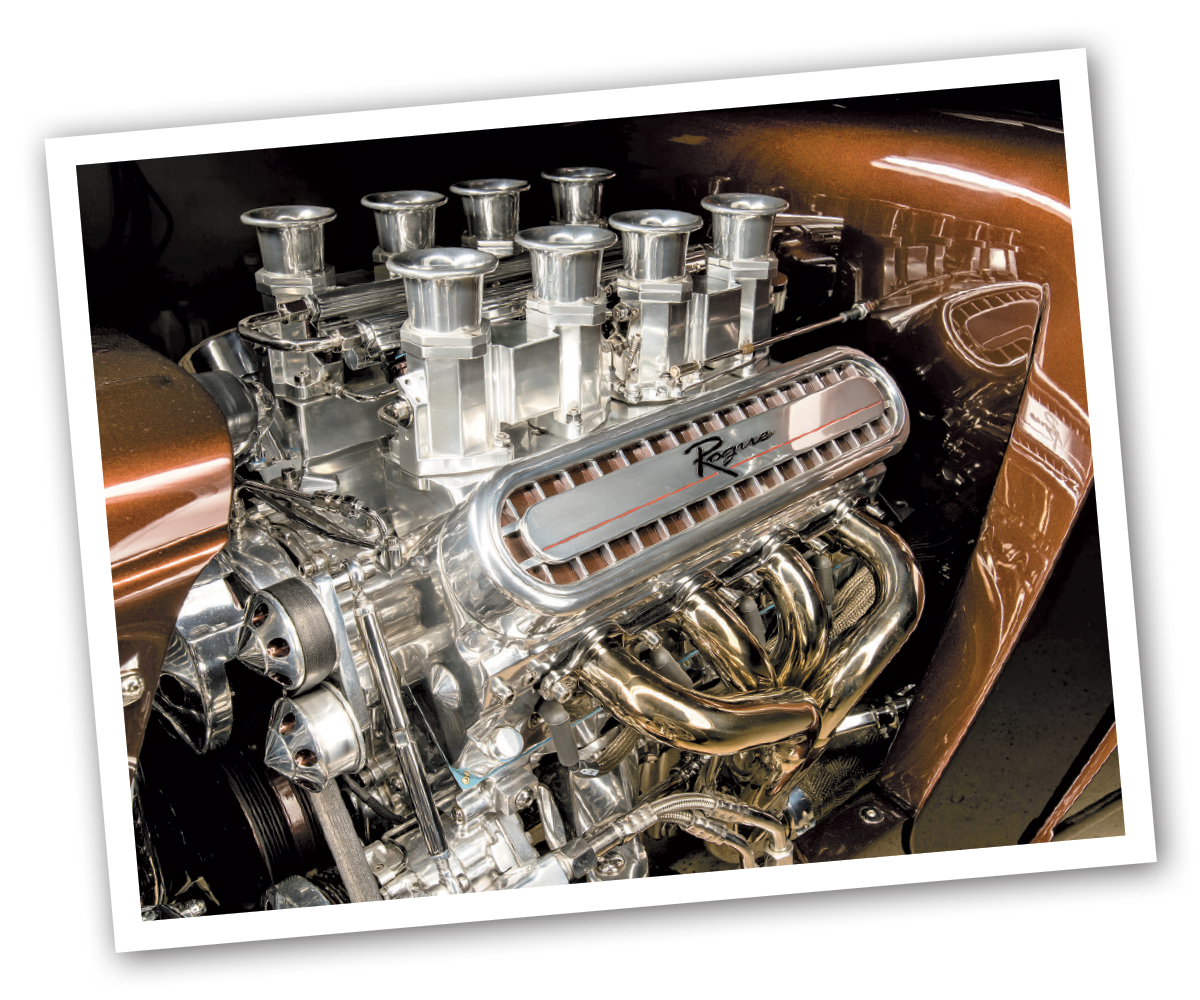
his 1933 Ford five-window coupe began its life as a Gibbon Fiberglass body. It was from this start that Rocky Boler began the obsession that turned this work of ’glass into a hot rod work of art. He teamed up with Mark and Heather Giambalvo of Creative Rod & Kustom (Womelsdorf, Pennsylvania) and the long list of modifications began, yielding this final award-winning result.
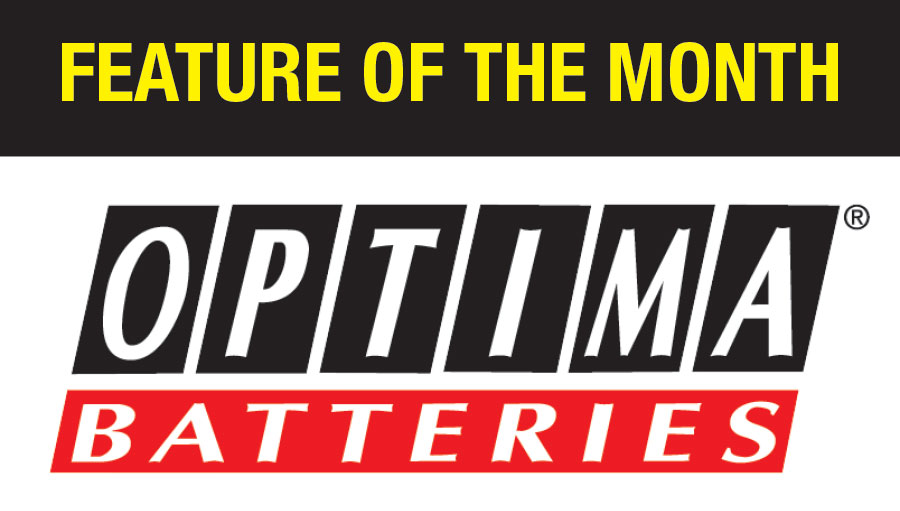

his 1933 Ford five-window coupe began its life as a Gibbon Fiberglass body. It was from this start that Rocky Boler began the obsession that turned this work of ’glass into a hot rod work of art. He teamed up with Mark and Heather Giambalvo of Creative Rod & Kustom (Womelsdorf, Pennsylvania) and the long list of modifications began, yielding this final award-winning result.



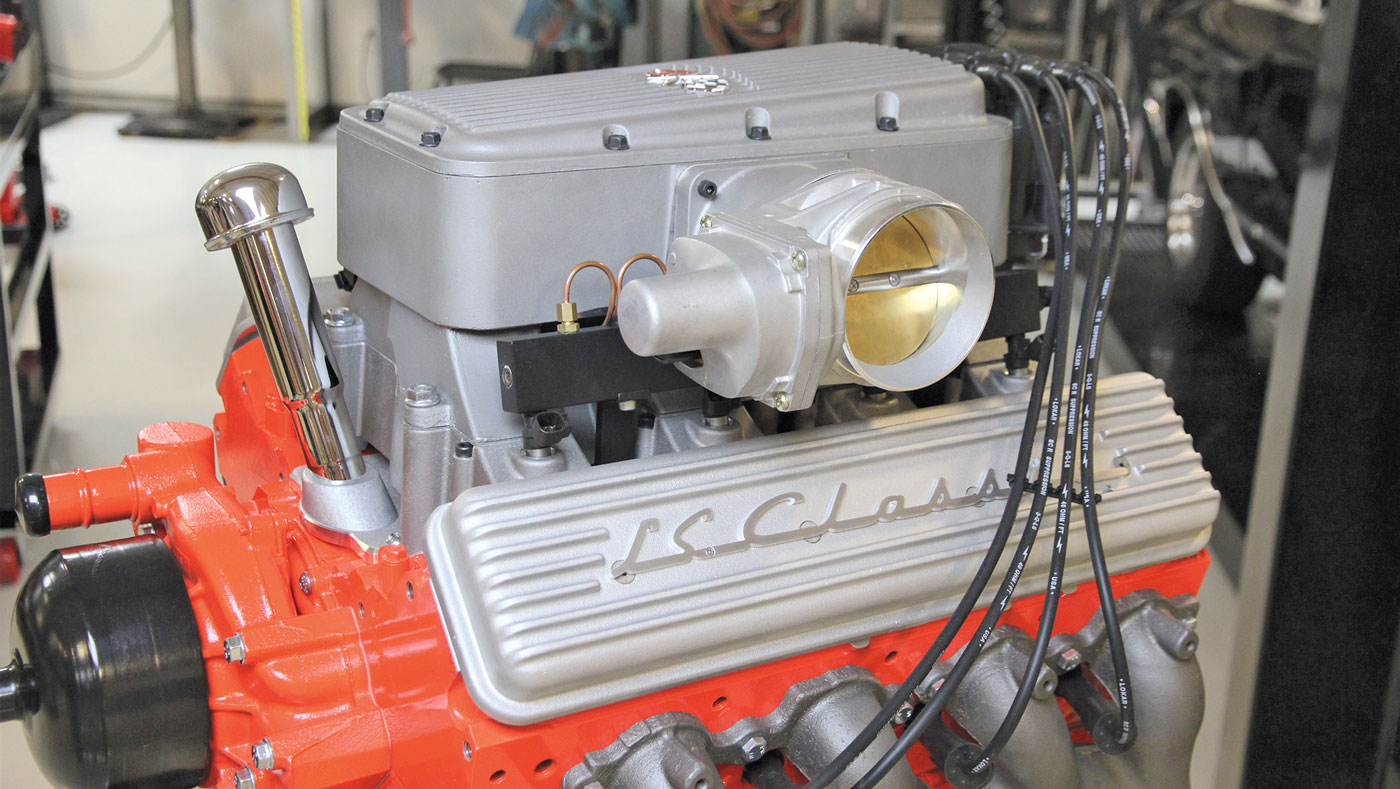
o say that the LS engine appears to be omnipresent and swapped into just about every car, truck, and street rod imaginable is to merely re-state the obvious. So, it’s no surprise that the more enterprising street rodders might want to search out older engines for something a little different. The problem is that old engines are just that—old technology. Not only do they leak oil and struggle to make underwhelming power, the original pieces are becoming harder to find. Those are just some of the reasons why the LS has gained such a following.
So, the next logical evolution in this creative thought process is to somehow make the LS look like an older engine. Something like a 1962 Corvette fuelie 327, for example. Almost six decades have passed since the early 327 Rochester Ramjet fuelie engines were at the pinnacle of the Christmas present wish list.
The guys at LS Classic Series by Lokar decided to act on that retro-plan and build a manifold that not only looks like a fuelie manifold but emphasizes the image by matching it with a set of ribbed valve covers, an intake valley cover with a chrome oil filler tube, and even a simulated distributor sticking up out of the back of the engine.
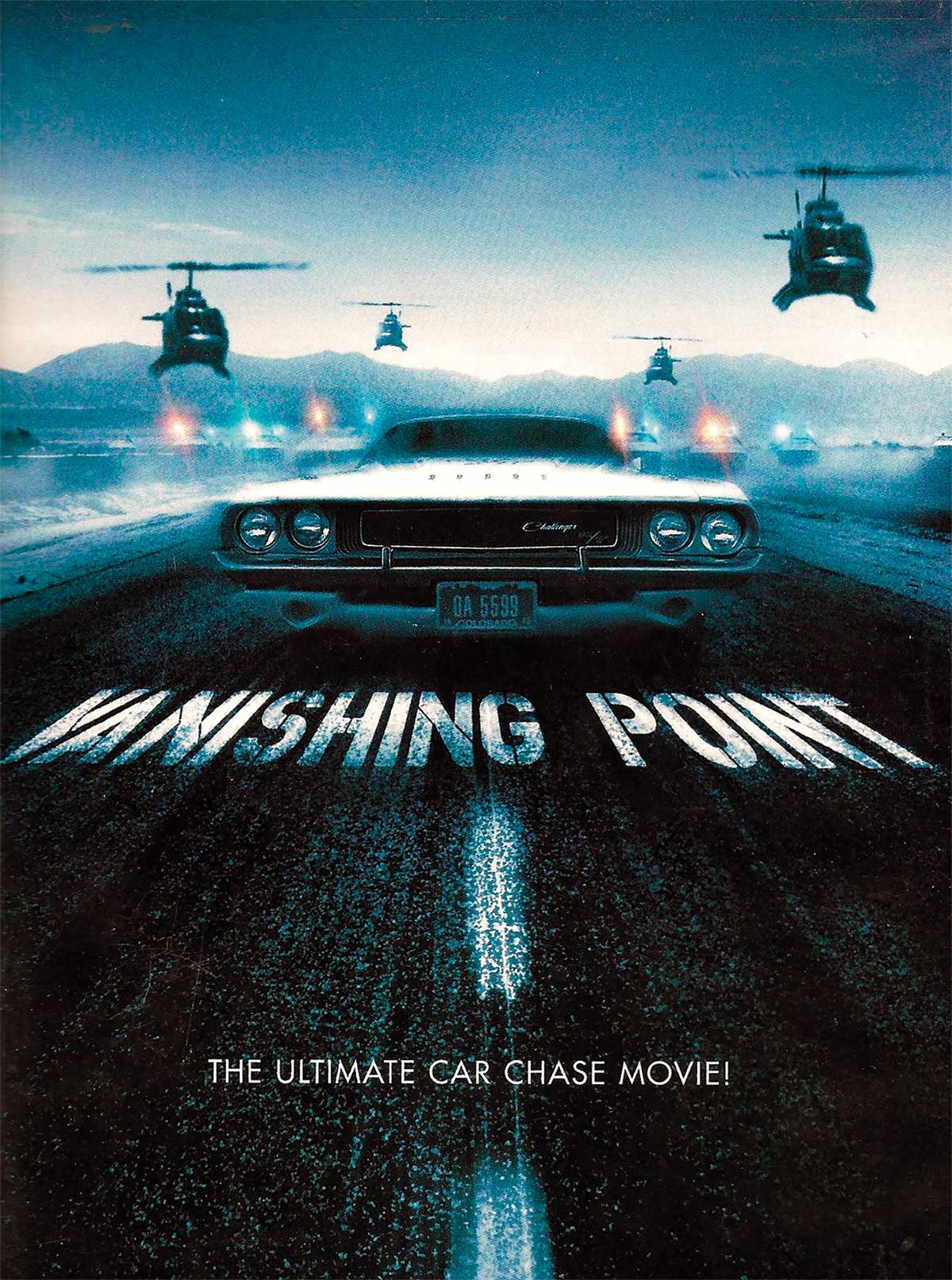

ar chase movies were nothing new; the best ever, Steve McQueen’s Bullitt, was then but a few years old. Director Richard C. Serafian insists his Vanishing Point isn’t a drug culture flick, but instead a “tapestry of many different levels of Americana.” While that may be true, the film’s characters sure popped a lot of speed and smoked more than a few joints in the process.
The film’s principal characters are Kowalski (first name unknown), played by Barry Newman in only his second major film role, and a grumbling Dodge Challenger R/T 440 Magnum four-speed. Kowalski is complex; a has-been car and motorcycle racer, decorated ’Nam vet, and former cop. Having washed out of most of his previous careers, he now works as an over-the-road car delivery driver hired to safely chauffeur the white Challenger from Colorado to San Francisco. Newman was a solid choice—trim, blue-eyed, and handsome; he exuded somewhat of a darker-haired McQueenesque vibe.
As the script called for all manner of automotive mayhem, Serafian engaged Carey Loftin, the shaman of action driving and stunt coordination in America at the time. Loftin could make cars fly and land with precision; his timing and car control well demonstrated in Bullitt. Another Bullitt production vet was race car builder/driver Max Balchowsky. (Hot rod aficionados will recognize this name. He designed and built nine Old Yeller/Ol’ Yaller cars. The first two were named after Old Yeller, a 1957 Disney film—and this editor’s favorite movie prior to the age of cars, which was around 10 years old. History tells us that Disney wasn’t fond of the name association so Balchowsky altered the name to read and spell “Ol’ Yaller”.) He performed relatively little mod work on the Challengers cued up for Vanishing Point. Most of his efforts took the form of repairing damage incurred during filming, and keeping the cars running and in one piece, reputedly often borrowing pieces from one to bandage another.

odern Rodding
opted to pay homage to Mopar’s contribution to hot rodding in a unique way by recognizing this four-year project, a 1971 Plymouth ’Cuda belonging to Kent and Lisa Matranga of Dana Point, California. To complete the celebration, MR has, elsewhere in this issue, a story on the 50th anniversary of the movie Vanishing Point. The 1970 Dodge Challenger from Vanishing Point and this 1971 Plymouth ’Cuda do share family similarities, all the while having their own characteristics and fan base. The third-gen ’Cuda was manufactured from 1970 to 1974 and was based on the Chrysler E-body (formerly an A-body).
odern Rodding
opted to pay homage to Mopar’s contribution to hot rodding in a unique way by recognizing this four-year project, a 1971 Plymouth ’Cuda belonging to Kent and Lisa Matranga of Dana Point, California. To complete the celebration, MR has, elsewhere in this issue, a story on the 50th anniversary of the movie Vanishing Point. The 1970 Dodge Challenger from Vanishing Point and this 1971 Plymouth ’Cuda do share family similarities, all the while having their own characteristics and fan base. The third-gen ’Cuda was manufactured from 1970 to 1974 and was based on the Chrysler E-body (formerly an A-body).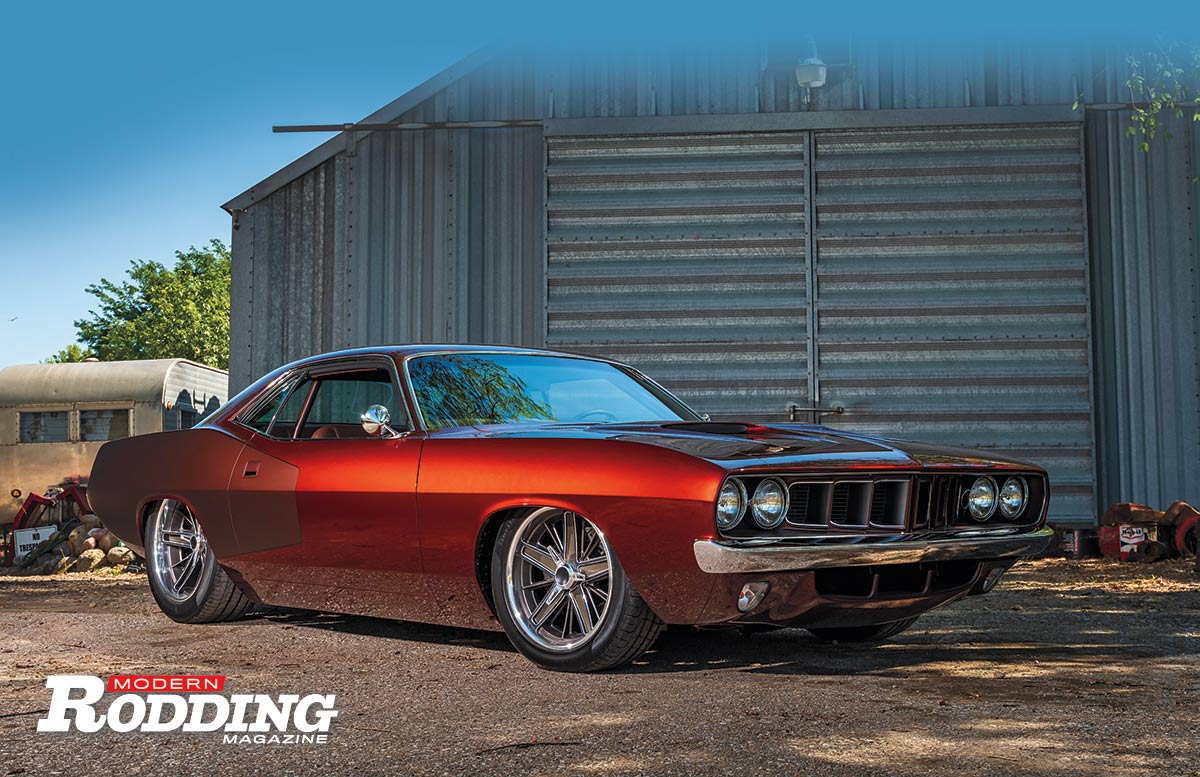
Let’s begin by covering some of the basics on where this ’Cuda came from and who is responsible for its build. Kent and Lisa are the proud owners but it should be noted Kent’s ideas made it through the “ink to paper” phase by way of Ragle Design. From here it was up to Andy Leach and his artisans in all things fabrication to body- and paintwork from Cal Auto Creations (Jim Karls, Eric Hanson, Matt Summers, Paul Caruana, Ethan Janson, Tommy Brandt, Steve Socha, Taylor Bonnstetter, Scott Clark, Scott Scheckloth, and Brian Dinsmore) to bring the ’Cuda to life.

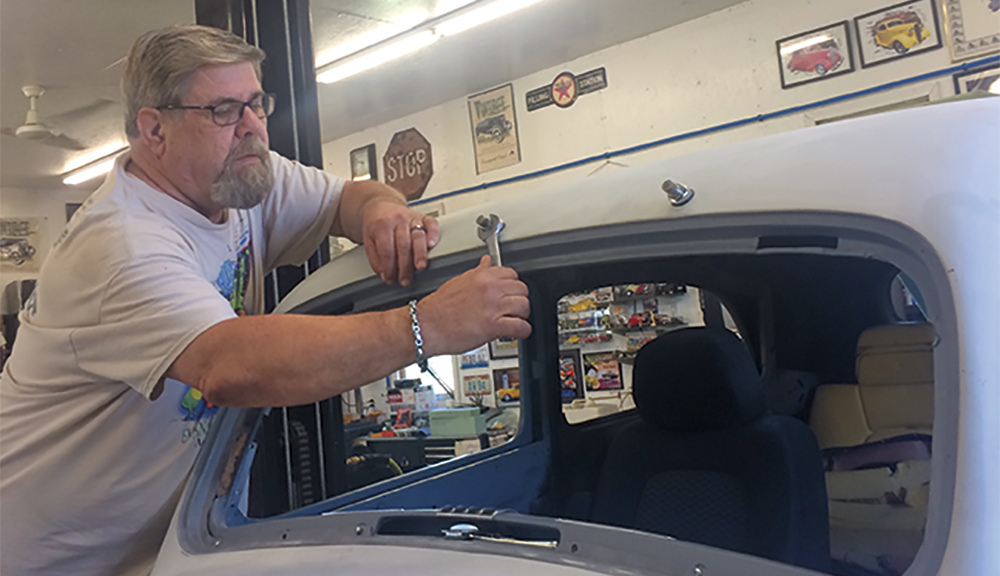
ell, Ol’ Man Winter is at it again. This time John Winter is updating his 1936 Ford with the New Port Engineering (NPE) (Washington, Missouri) Clean Drive Wiper Drive System. Within the original product line is the Clean Wipe System featuring mounting brackets, linkage arms, and wiper transmissions. It’s designed to operate on two wiper arms and blades in vehicles originally equipped with a single vacuum wiper.
There were several shortcomings on prewar American cars, most noticeably was the vacuum-operated wiper. When all things were in good repair the wipers were “OK,” yet should you find yourself in the middle of a “toad floater” or an “Alaskan drizzle,” throw in tired or worn vacuum lines and seeing the road ahead was more of a leap of faith than smart driving. How many times have you tried to drive around a rainstorm rather than drive through it? I’m guessing many of us have experienced the “slow-fast-slow-fast” rhythm of vacuum-operated wipers. It was fun when the wipers weren’t needed but extremely frustrating when you were counting on them.


im Bobowski is an avid hot rod archaeologist, constantly turning over automotive “rocks” in the hopes of discovering bits of hot rod history. Turns out he’s pretty good at it. Digging through swap meets, Internet sites, and old garages has garnered some interesting bits, but around the turn of the century Jim was in search of a historic hot rod, a car with provenance. And so, when he discovered the famed Bob Pierson 1936 Ford coupe was known to exist, he began the search. It turns out one of his greatest discoveries was hiding under a bright red paintjob and the owner, Frank Nay, along with several other veteran hot rodders, was well aware of this particular 1936 Ford coupe’s storied past. How aware, you ask? Well, he was there when this coupe was setting records on the dry lakes in the ’40s as a fellow member of the RTA. So, the good news is Jim had found the coupe, the bad news was Nay had no interest in selling the car. However, Jim and Nay became friends and stayed in touch.

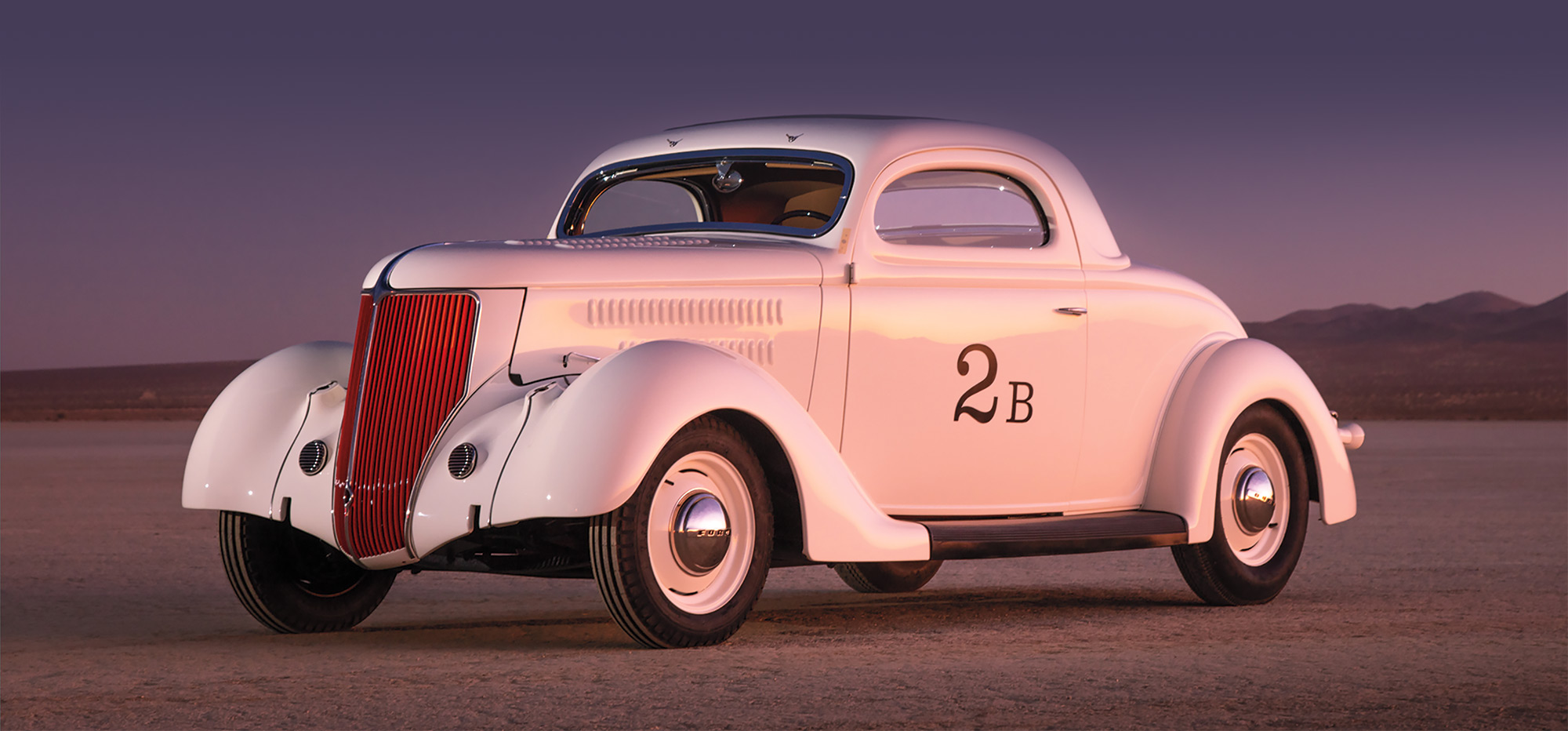

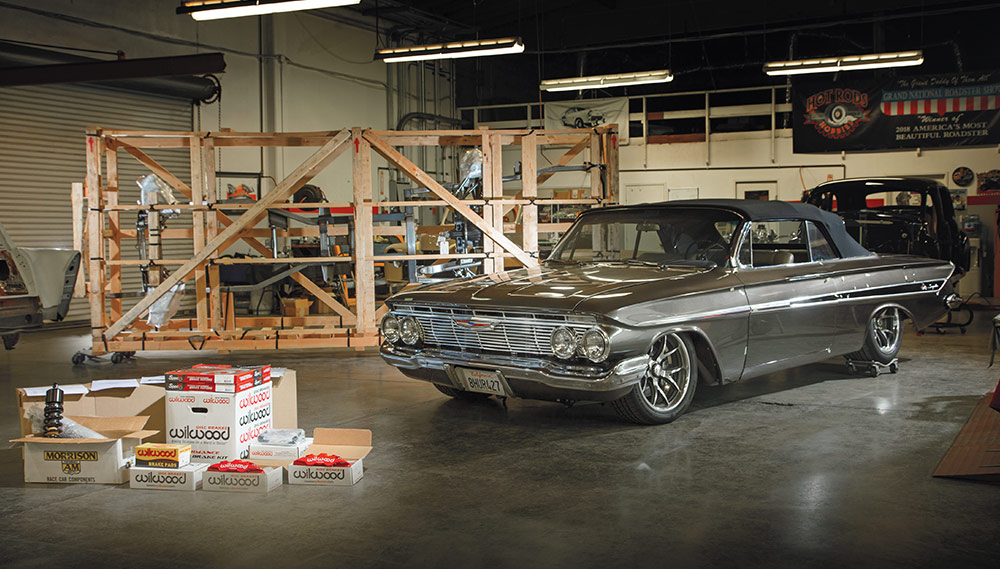
t’s been 17-plus years since Art and Craig Morrison of Art Morrison Enterprises (AME) drove south in their patina 1955 Chevy outfitted with their initial GT Sport chassis. Art and Craig brought it around to show off their enthusiasm in the hopes of getting the auto magazine world excited. Well, they did and it did. Nearly 20 miles of 2×4-inch rectangular tubing and 1,700 Tri-Five chassis later, AME is an established, and we might say iconic, brand within our industry. I still remember Art telling me, “It was a blast to drive and we looked for every offramp and onramp we could find just so we could enjoy the thrill and sit back and giggle.”
Our goal was achieved when Tim Sutton (photo eye extraordinaire) was speaking with Scott Bonowski of Hot Rods & Hobbies (Signal Hill, California) about some upcoming feature cars when Sutton noticed a 1961 Chevy Impala convertible off to the side of the 13,000-square-foot shop. Next to it was this rather large shipping crate built around what was clearly a fullsize car chassis and also packed with a number of boxes that contained such items as a Wilwood spindle and brake package (14-inch rotor), Strange Engineering coilover shocks and rear differential, and AME engine and transmission mounts. It’s also fitted with a Detroit Speed rack-and-pinion steering (20:1), which is the “everyday” street steering. Ol’ Eagle Eye Sutton also noticed this frame was equipped with the optional IRS. Bonowski is no stranger to installing the AME chassis so we knew we were in the right place to get our job done.

1972 Ford is at Home in any Crowd

hat first grabbed our attention about this 1972 Ford Maverick was the “electric” blue paint. There’s no missing this hot rod when making the rounds at any car show or rod run. Glenn Sinon of West Suffield, Connecticut, began this project with the idea that it would be a “low-dollar” driver for Hannah, his teenage daughter. We are guessing Glenn will back us up when we say that he “overshot the runway” on this landing.

As you go over the photos you will see a first-rate build that was an “at-home” project—all 2,000 hours! The original plan called for a $5,000 budget, a recycled engine and trans, and a quickie paintjob. All this so that his then 5-year-old daughter would have a cool first car when the time came.
Not one to rush into any build, the car was brought home from a buddy’s house where it had sat for 19 years. (Originally it was an Alabama Maverick that found its way to Connecticut.) It was now 2009 and Glenn parked it until 2011 when he began and wrapped it up in 2018. Glenn tells us he spent countless hours while tucked away in his garage. He did turn over the transmission build, exhaust fabrication, and interior to outsiders. Impressive, yet we keep coming back to the color. Now is a good time to reveal Glenn’s special inside track on paint and painting. He’s a professed bodyman and is a training instructor for PPG Automotive Refinish. It’s now becoming clear how this color came about. The Venom Blue was self-named and mixed by Glenn utilizing PPG Envirobase Plus Waterborne paint along with D8152 Glamour Clear from PPG’s Global line.
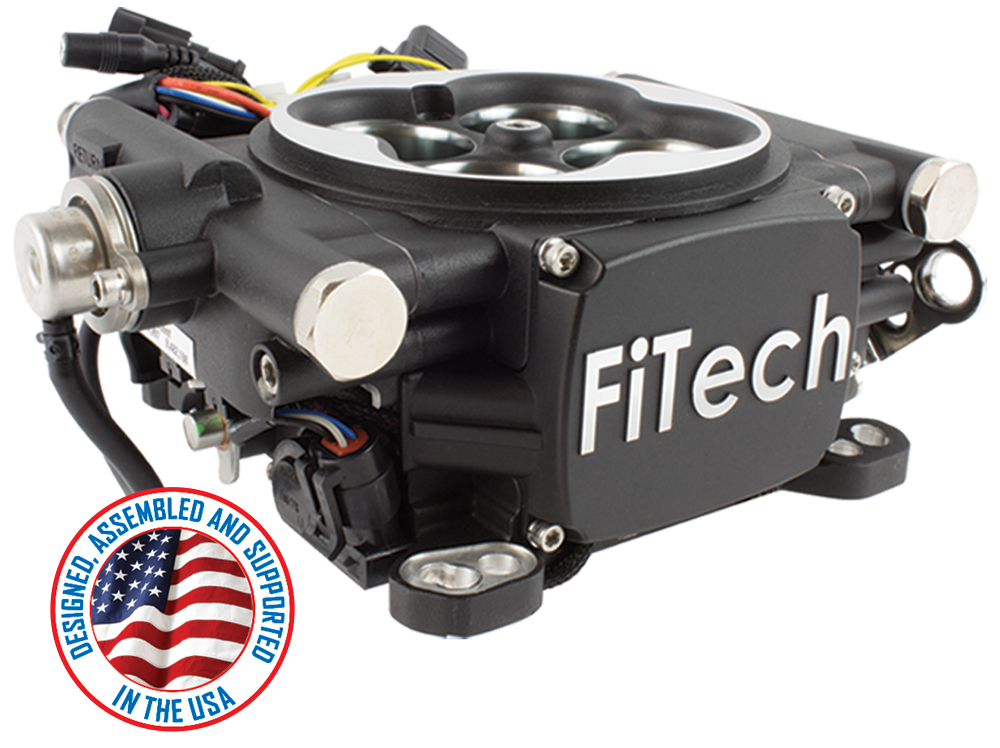
 Fuel Delivery Solutions
Fuel Delivery Solutions High Output Ignitions
High Output Ignitions Trans Controls & More
Trans Controls & More
 Fuel Delivery Solutions
Fuel Delivery Solutions High Output Ignitions
High Output Ignitions Trans Controls & More
Trans Controls & More
 Fuel Delivery Solutions
Fuel Delivery Solutions High Output Ignitions
High Output Ignitions Trans Controls & More
Trans Controls & More

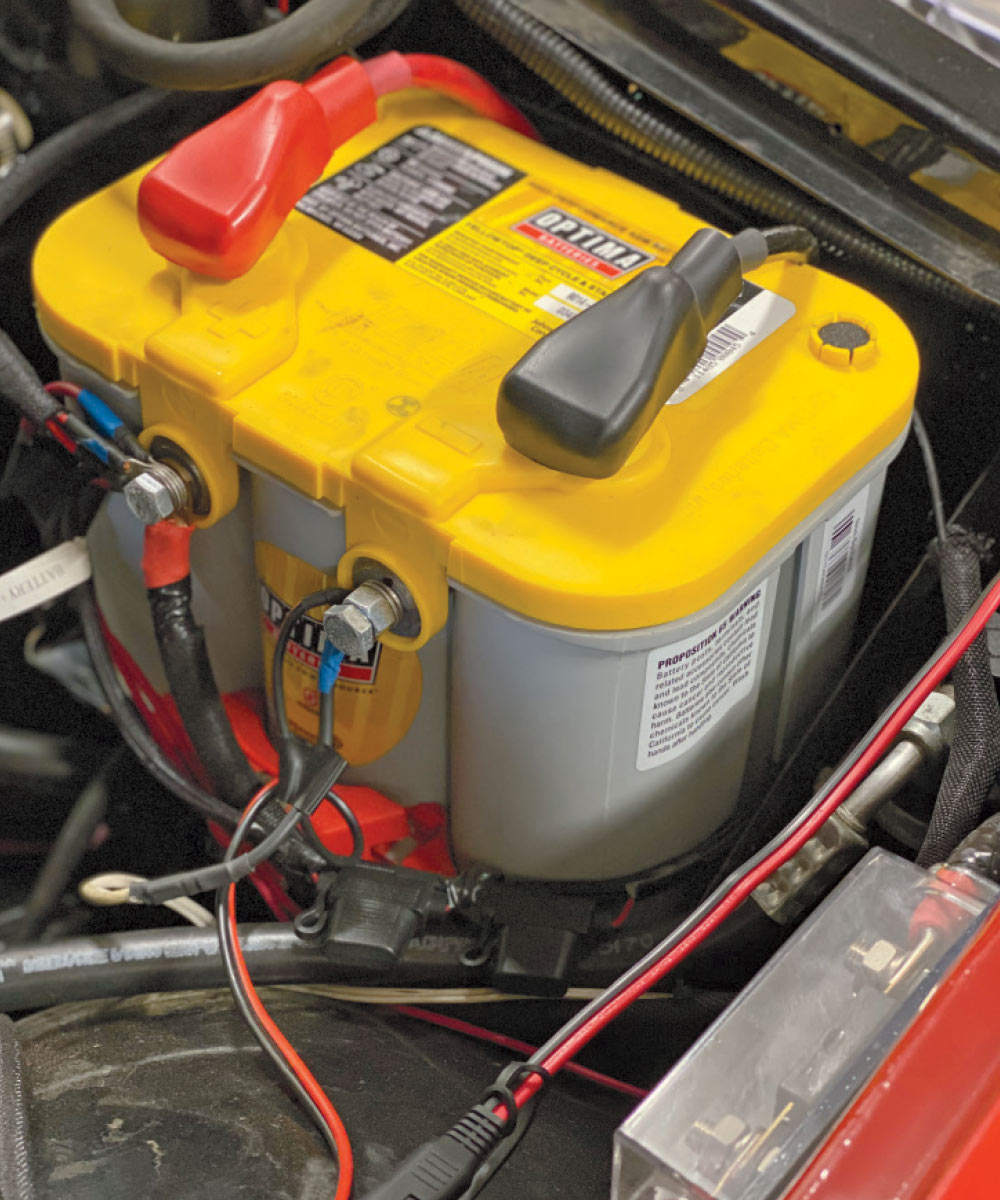

t best our hot rods are driven infrequently and clearly not as much as we would like. For many the winter climate precludes a number of us from driving these cars at all, at least until the fair-weather season. As such, keeping our cars in running order begins with a fully charged battery. A simple and fundamental thought, but to do this we need to understand some basics, such as our car’s battery, battery chargers (maintainers), and battery parasitic loss (draw).
To better understand what it takes to keep our hot rod “at the ready,” let’s take a look at the Optima chargers, batteries, and one hot rodder’s experience with parasitic loss … me! I found myself gaining a greater understanding through insight as to the problems, the cause, and the correction(s).
I have my Optima Digital 400 charger attached to my roadster year-round. It never lets me down and the roadster is always at the ready. I now have three hot rods (1972 Suburban, 1968 Corvette, and 1929 Ford highboy roadster) that are running that I like to drive as often as possible. And, they all need battery maintenance. But there’s more to this electrical puzzle than just keeping your battery fully charged.


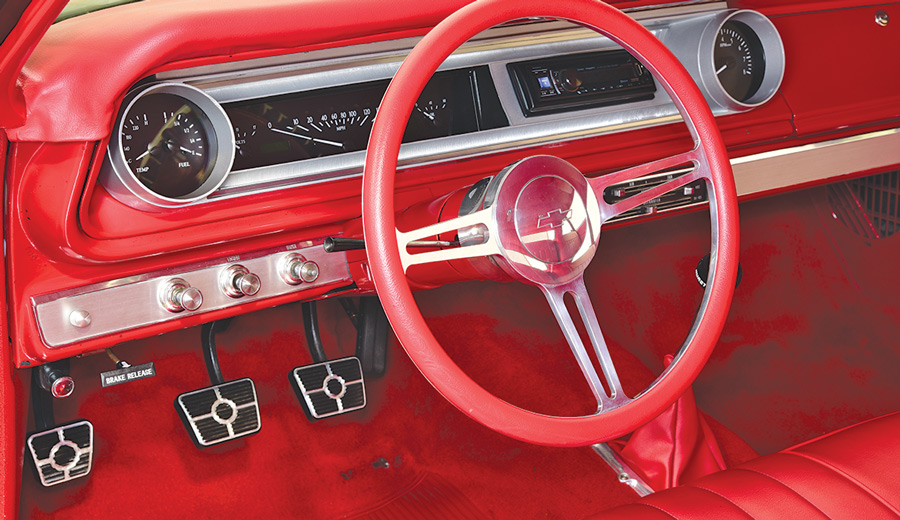
amaraderie, it’s one of the core values that frames the hot rodding hobby. Regardless which decade you grew up in, like-minded performance enthusiasts have regularly gathered in friends’ driveways, home garages, service stations, and even doughnut shop parking lots to tell tall tales and work on their hop-ups. It didn’t matter if it was to fix something that broke the night before, taking on a driveline swap, or simply adding some new jets to a carburetor. In any case there’s nothing like hanging out with your friends while enjoying the hobby.
After making the decision a few years later to start the search for his own project, it wasn’t long till he located a well-sorted 1965 Bel Air in nearby New Hampshire. The car packed a 396ci big-block linked to a four-speed and was a solid start, so a deal was made and the keys changed hands. While Dave enjoyed the car, it wasn’t long till he and Bishop pulled the engine in favor of a 572ci Chevrolet Performance V-8 for an extra power punch. Wanting to bring the car to the next level, he contacted Chris Cerce Customs in Taunton, Massachusetts, to go over his thoughts. Cerce outlined plenty of potential ideas for the car’s rebirth, including a number of performance upgrades, and soon after it was delivered for a full build.
Once the car was torn down the original spine was blasted clean, painted, and treated to additional bracing to stiffen it up. Out back a GM 12-bolt rearend was packed with Strange Engineering 31-spline axles linked to a Detroit Eaton Truetrac turning 3.73 gears. It’s suspended in place by a combination of Global West adjustable upper tubular control arms with matching lower arms, Panhard bar, and QA1 coilover shocks. To add plenty of razor-sharp handling Global West tubular upper and lower control arms are combined with matching 2-inch drop spindles and QA1 coilover shocks. When it’s time to stop on a dime, fluid moves through a Classic Performance Products HydraStop unit capped by a Baer Remaster to stainless lines with matching 14-inch two-piece drilled-and-slotted discs with six-piston calipers at each corner. For plenty of style, 18×10 front and 18×12 rear Billet Specialties SLC Series Turbine-model wheels wear low-profile Nitto NT555 G2 rubber.

et’s face it, when it comes to hot rod motors nothing says performance quite like multiple carburetors. Even the uninitiated can gaze under an open hood and announce with authority … “wow, dual-quads” or “three deuces,” tri-power for Pontiac lovers, and the list goes all the way up to six-twos. Of course, having owned my fair share of cars with multiple carbs—and I even own one with “dual-quads” that are actually dual EFI units—I fully understand that while performance may be enhanced, the bigger impact often comes in the form of hot rod eye candy.
Now none of this was lost on my longtime pal Larry Shoaf. A metal man extraordinaire, Shoaf basically hand-formed at least 70 percent of his 1927 Chrysler track roadster. Rescued from the woods, it was the proverbial “rusted to the door handles” example, but being a Mopar guy, Shoaf knew the answer when the owner queried, “When’s the last time you saw a 1927 Chrysler roadster?” And so he hauled them home (yes, remarkably the guy had two 1927 Chrysler roadsters side by side in the woods behind his house) and began to form one very cool track-style roadster. One of the key elements in the design was forming a custom three-piece hood with a trio of Stellings & Hellings air breathers peeking just above the hood line. The carbs would be perched atop a warmed-over 318ci motor, keeping things all Mopar. The induction setup was actually ordered direct from Mopar and included the intake, linkage, and carbs. Originally designed for the 340 Six-Pack motor, the intake fit just fine atop the 318.
View Index
View Index
